Search Result
Results for "
3,3'-T2-<sup>13</sup>C<sub>6</sub>
" in MedChemExpress (MCE) Product Catalog:
100
Isotope-Labeled Compounds
| Cat. No. |
Product Name |
Target |
Research Areas |
Chemical Structure |
-
- HY-D0844S
-
|
L-Glutathione oxidized-<sup>13sup>C<sub>4sub>,<sup>15sup>N<sub>2sub>; GSSG-<sup>13sup>C<sub>4sub>,<sup>15sup>N<sub>2sub>; Oxiglutatione-<sup>13sup>C<sub>4sub>,<sup>15sup>N<sub>2sub>
|
Endogenous Metabolite
Reactive Oxygen Species
|
Metabolic Disease
|
|
Glutathione oxidized- 13C4, 15N2 is the 13C and 15N labeled Glutathione oxidized (HY-D0844). Glutathione oxidized is produced by the oxidation of glutathione. Detoxification of reactive oxygen species is accompanied by production of glutathione oxidized. Glutathione oxidized can be used for the research of sickle cells and erythrocytes[1][2].
|
-

-
- HY-D0184S3
-
|
Deoxycytidine-<sup>13sup>C<sub>9sub>,<sup>15sup>N<sub>3sub>; Cytosine deoxyriboside-<sup>13sup>C<sub>9sub>,<sup>15sup>N<sub>3sub>; Deoxyribose cytidine-<sup>13sup>C<sub>9sub>,<sup>15sup>N<sub>3sub>
|
Isotope-Labeled Compounds
Endogenous Metabolite
|
Others
|
|
2'-Deoxycytidine- 13C9, 15N3 (Deoxycytidine- 13C9, 15N3; Cytosine deoxyriboside- 13C9, 15N3; Deoxyribose cytidine- 13C9, 15N3) is 13C and 15N-labeled 2'-Deoxycytidine (HY-D0184). 2'-Deoxycytidine, a deoxyribonucleoside, could inhibit biological effects of Bromodeoxyuridine (Brdu).
|
-
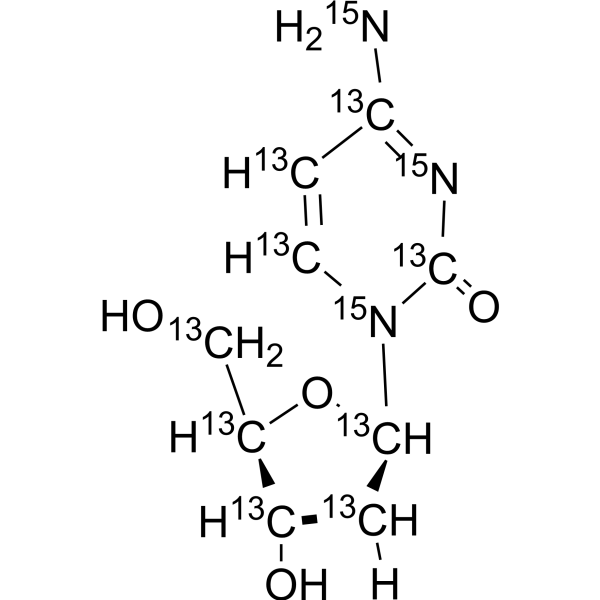
-
- HY-N1150S8
-
|
DThyd-<sup>13sup>C<sub>10sub>,<sup>15sup>N<sub>2sub>; NSC-<sup>13sup>C<sub>10sub>,<sup>15sup>N<sub>2sub>
|
DNA/RNA Synthesis
Endogenous Metabolite
Orthopoxvirus
|
Cancer
|
|
Thymidine- 13C10, 15N2 is the 13C and 15N labeled Thymidine[1]. Thymidine, a specific precursor of deoxyribonucleic acid, is used as a cell synchronizing agent. Thymidine is a DNA synthesis inhibitor that can arrest cell at G1/S boundary, prior to DNA replication[2][3][4].
|
-

-
- HY-N0623S4
-
|
Tryptophan-<sup>13sup>C<sub>11sub>,<sup>15sup>N<sub>2sub>; Tryptophane-<sup>13sup>C<sub>11sub>,<sup>15sup>N<sub>2sub>
|
Endogenous Metabolite
|
Metabolic Disease
|
|
L-Tryptophan- 13C11, 15N2 is the 13C- and 15N-labeled L-Tryptophan. L-Tryptophan (Tryptophan) is an essential amino acid that is the precursor of serotonin, melatonin, and vitamin B3[1].
|
-

-
- HY-N0097S6
-
|
DL-Guanosine-<sup>13sup>C<sub>10sub>,<sup>15sup>N<sub>5sub>; Vernine-<sup>13sup>C<sub>10sub>,<sup>15sup>N<sub>5sub>
|
HSV
Isotope-Labeled Compounds
|
Infection
|
|
Guanosine- 13C10, 15N5 is the 13C and 15N labeled Guanosine (HY-N0097). Guanosine (DL-Guanosine) is a purine nucleoside comprising guanine attached to a ribose (ribofuranose) ring via a β-N9-glycosidic bond. Guanosine possesses anti-HSV activity .
|
-

-
- HY-A0061S
-
|
Trifluorothymidine-<sup>13sup>C,<sup>15sup>N<sub>2sub>; 5-Trifluorothymidine-<sup>13sup>C,<sup>15sup>N<sub>2sub>; TFT-<sup>13sup>C,<sup>15sup>N<sub>2sub>
|
Thymidylate Synthase
Nucleoside Antimetabolite/Analog
HSV
Orthopoxvirus
|
Cancer
|
|
Trifluridine- 13C, 15N2 is the 13C and 15N labeled Trifluridine[1]. Trifluridine (Trifluorothymidine;5-Trifluorothymidine;TFT) is an irreversible thymidylate synthase inhibitor, and thereby suppresses DNA synthesis. Trifluridine is an antiviral agent for herpes simplex virus (HSV) infection. Trifluorothymidine also has anti-orthopoxvirus activity[2].
|
-

-
- HY-108213S
-
|
5'-IMP-<sup>13sup>C<sub>10sub>,<sup>15sup>N<sub>4sub> dilithium; IMP-<sup>13sup>C<sub>10sub>,<sup>15sup>N<sub>4sub> dilithium; Inosine 5'-dihydrogen phosphate-<sup>13sup>C<sub>10sub>,<sup>15sup>N<sub>4sub> dilithium
|
Isotope-Labeled Compounds
|
Metabolic Disease
|
|
Inosinic acid- 13C10, 15N4 dilithium (5'-IMP-13C10,15N4 (dilithium); IMP-13C10,15N4 (dilithium); Inosine 5'-(dihydrogen phosphate)-13C10,15N4 (dilithium)) is 13C- and 15N-labeled Inosinic acid (HY-108213). Inosinic acid is an endogenous metabolite .
|
-

-
- HY-N0091S
-
-
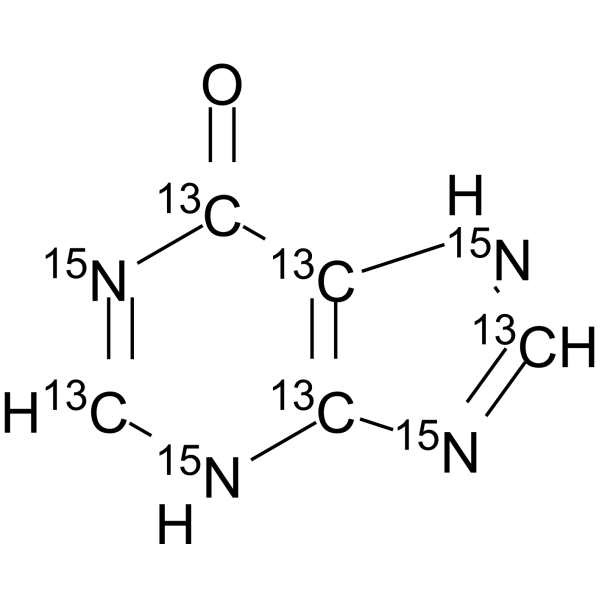
-
- HY-B1118S1
-
|
RP-14539-<sup>13sup>C<sub>2sub>, <sup>15sup>N<sub>2sub>; PM-185184-<sup>13sup>C<sub>2sub>, <sup>15sup>N<sub>2sub>
|
Isotope-Labeled Compounds
Parasite
Antibiotic
|
Infection
|
|
Secnidazole- 13C2, 15N2 is the 13C2, 15N2 labeled Secnidazole. Secnidazole (RP-14539;PM-185184) is an orally active azole antibiotic with a longer half-life than metronidazole (HY-B0318). Secnidazole is against the vaginosis-associated bacteria and has the potential for bacterial vaginosis research.
|
-

-
- HY-17563S1
-
|
Deoxyguanosine-<sup>13sup>C<sub>10sub>,<sup>15sup>N<sub>5sub>; Guanine deoxyriboside-<sup>13sup>C<sub>10sub>,<sup>15sup>N<sub>5sub>
|
Isotope-Labeled Compounds
|
Cancer
|
|
2'-Deoxyguanosine- 13C10, 15N5 (Deoxyguanosine- 13C10, 15N5; Guanine deoxyriboside- 13C10, 15N5) is a 13C- and 15N-labeled 2'-Deoxyguanosine (HY-17563).
|
-
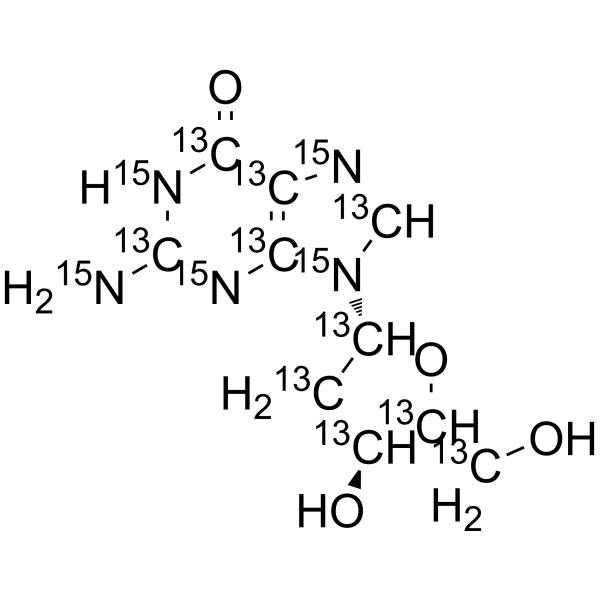
-
- HY-B0456S
-
|
Vitamin B2-<sup>13sup>C<sub>4sub>,<sup>15sup>N<sub>2sub>; E101-<sup>13sup>C<sub>4sub>,<sup>15sup>N<sub>2sub>
|
Isotope-Labeled Compounds
Endogenous Metabolite
|
Others
|
|
Riboflavin- 13C4, 15N2is the 13C-labeled and 15N-labeled Riboflavin. Riboflavin is an easily absorbed micronutrient with a key role in maintaining health in humans and other animals.
|
-
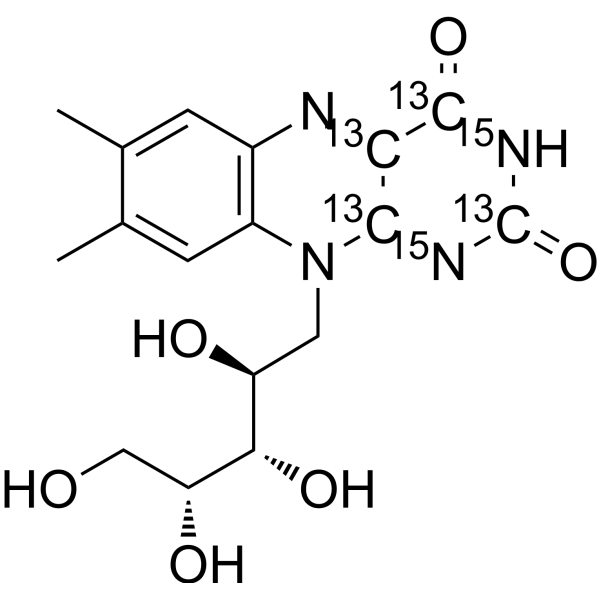
-
- HY-Y0219S
-
|
s-Triazole<sup>13sup>C<sub>2sub>,<sup>15sup>N<sub>3sub>; Pyrrodiazole<sup>13sup>C<sub>2sub>,<sup>15sup>N<sub>3sub>
|
Isotope-Labeled Compounds
|
Others
|
|
NSC 83128- 13C2, 15N3 is the 13C and 15N labeled NSC 83128[1].
|
-

-
- HY-107372S
-
|
UTP-<sup>13sup>C<sub>9sub>,<sup>15sup>N<sub>2sub> sodium; Uridine 5'-triphosphate-<sup>13sup>C<sub>9sub>,<sup>15sup>N<sub>2sub> sodium
|
DNA/RNA Synthesis
Nucleoside Antimetabolite/Analog
|
Infection
Cancer
|
|
Uridine triphosphate- 13C9, 15N2 (sodium) is a labeled Uridine triphosphate sodium. Uridine triphosphate sodium can be used in nucleic acid synthesis.
|
-
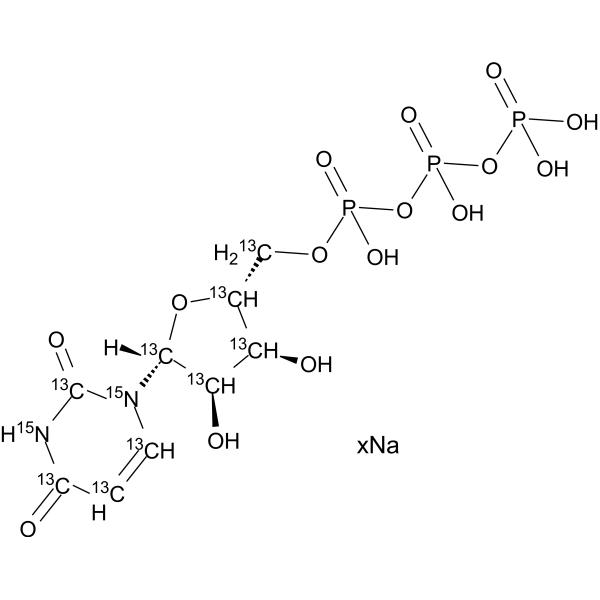
-
- HY-W011240S1
-
|
Methforylthiazidine-<sup>15sup>N<sub>2sub>,<sup>13sup>C,d<sub>2sub>; Rontyl-<sup>15sup>N<sub>2sub>,<sup>13sup>C,d<sub>2sub>
|
Isotope-Labeled Compounds
|
Others
|
|
Hydroflumethiazide- 15N2, 13C,d2 is the 13C- and 15N-labeled Hydroflumethiazide[1].
|
-
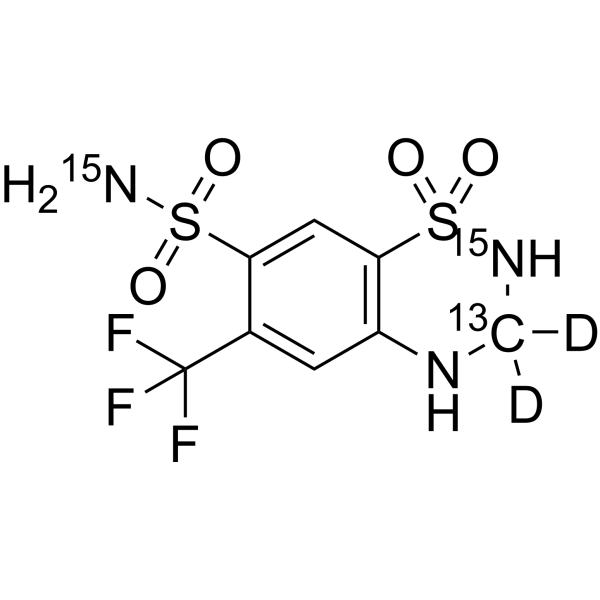
-
- HY-B0152S2
-
|
6-Aminopurine-<sup>13sup>C<sub>5sub>,<sup>15sup>N<sub>5sub>; Vitamin B4-<sup>13sup>C<sub>5sub>,<sup>15sup>N<sub>5sub>
|
Isotope-Labeled Compounds
DNA/RNA Synthesis
Endogenous Metabolite
|
Cancer
|
|
Adenine- 13C5,15C5 (6-Aminopurine- 13C5,15C5; Vitamin B4- 13C5,15C5) is 13C-labeled Adenine (HY-B0152). Adenine (6-Aminopurine), a purine, is one of the four nucleobases in the nucleic acid of DNA. Adenine acts as a chemical component of DNA and RNA. Adenine also plays an important role in biochemistry involved in cellular respiration, the form of both ATP and the cofactors (NAD and FAD), and protein synthesis.
|
-

-
- HY-A0161S
-
|
Clofedanol-<sup>13sup>C<sub>6sub>; Calmotusin-<sup>13sup>C<sub>6sub>; NSC 113595-<sup>13sup>C<sub>6sub>
|
Isotope-Labeled Compounds
|
Infection
|
|
Chlophedianol- 13C6 is the 13C labeled Chlophedianol (HY-A0161). Chlophedianol is an orally active and potent antitussive agent. Chlophedianol can be used for the research of acute cough due to upper respiratory tract infections (URIs)[1][2][3].
|
-

-
- HY-N0667S2
-
|
(-)-Asparagine-<sup>15sup>N<sub>2sub> monohydrate; Asn-<sup>15sup>N<sub>2sub> monohydrate; Asparamide-<sup>15sup>N<sub>2sub> monohydrate
|
Endogenous Metabolite
|
Neurological Disease
|
|
L-Asparagine- 15N2 (monohydrate) is the 15N-labeled L-Asparagine. L-Asparagine ((-)-Asparagine) is a non-essential amino acid that is involved in the metabolic control of cell functions in nerve and brain tissue.
|
-

-
- HY-N0667S3
-
|
(-)-Asparagine-<sup>13sup>C<sub>4sub> monohydrate; Asn-<sup>13sup>C<sub>4sub> monohydrate; Asparamide-<sup>13sup>C<sub>4sub> monohydrate
|
Isotope-Labeled Compounds
Endogenous Metabolite
|
Neurological Disease
|
|
L-Asparagine- 13C4 (monohydrate) is the 13C-labeled L-Asparagine. L-Asparagine ((-)-Asparagine) is a non-essential amino acid that is involved in the metabolic control of cell functions in nerve and brain tissue.
|
-

-
- HY-N0898S
-
|
(+)-Catechin-<sup>13sup>C<sub>3sub>; Cianidanol-<sup>13sup>C<sub>3sub>; Catechuic acid-<sup>13sup>C<sub>3sub>
|
COX
Apoptosis
Influenza Virus
Endogenous Metabolite
|
Cancer
|
|
Catechin- 13C3 is the 13C-labeled Catechin. Catechin ((+)-Catechin) inhibits cyclooxygenase-1 (COX-1) with an IC50 of 1.4 μM.
|
-
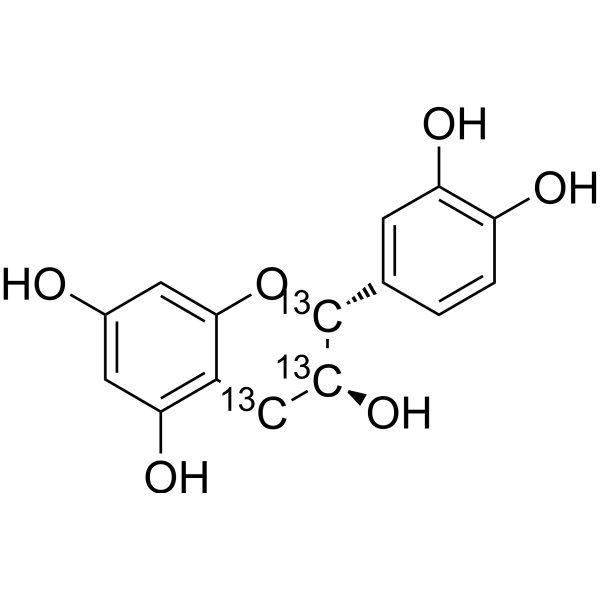
-
- HY-13458S1
-
|
L-DOPS-<sup>13sup>C<sub>2sub>,<sup>15sup>N hydrochloride; DOPS-<sup>13sup>C<sub>2sub>,<sup>15sup>N hydrochloride; SM5688-<sup>13sup>C<sub>2sub>,<sup>15sup>N hydrochloride
|
Adrenergic Receptor
Isotope-Labeled Compounds
|
Neurological Disease
|
|
Droxidopa- 13C2, 15N (hydrochloride) is deuterium labeled Droxidopa. Droxidopa(L-DOPS), the mixture of Droxidopa (w/w80%) and Pharmaceutical starch (w/w20%), acts as a proagent to the neurotransmitters norepinephrine (noradrenaline) and epinephrine (adrenaline); Droxidopa(L-DOPS) is capable of crossing the protective blood–brain barrier[1][2].
|
-

-
- HY-66005S4
-
|
Paracetamol-<sup>13sup>C<sub>2sub>,<sup>15sup>N; 4-Acetamidophenol-<sup>13sup>C<sub>2sub>,<sup>15sup>N; 4'-Hydroxyacetanilide-<sup>13sup>C<sub>2sub>,<sup>15sup>N
|
COX
Bacterial
Histone Acetyltransferase
Parasite
Endogenous Metabolite
|
|
|
Acetaminophen- 13C2, 15N is the 13C and 15N labeled Acetaminophen[1]. Acetaminophen (Paracetamol) is a selective cyclooxygenase-2 (COX-2) inhibitor with an IC50 of 25.8 μM;is a widely used antipyretic and analgesic agent[2][3][4]. Acetaminophen is a potent hepatic N-acetyltransferase 2 (NAT2) inhibitor[5].
|
-

-
- HY-10572S1
-
-

-
- HY-B0389A
-
|
Glucose-<sup>13sup>C<sub>6sub>; D-(+)-Glucose-<sup>13sup>C<sub>6sub>; Dextrose-<sup>13sup>C<sub>6sub>
|
Endogenous Metabolite
|
Others
Metabolic Disease
|
|
D-Glucose- 13C6 is a stable isotope-labeled counterpart of D-glucose (HY-B0389). D-Glucose- 13C6 can be used as a metabolic tracer to trace glucose-related synthetic catabolism or as synthesis ingredient, minimal media reagent, and internal standard .
|
-

-
- HY-B0389S14
-
|
Glucose-<sup>13sup>C<sub>2sub>; D-(+)-Glucose-<sup>13sup>C<sub>2sub>; Dextrose-<sup>13sup>C<sub>2sub>
|
Endogenous Metabolite
|
Metabolic Disease
|
|
D-Glucose- 13C2 is the 13C labeled D-Glucose. D-Glucose (Glucose), a monosaccharide, is an important carbohydrate in biology. D-Glucose is a carbohydrate sweetener and critical components of the general metabolism, and serve as critical signaling molecules in relation to both cellular metabolic status and biotic and abiotic stress response[1].
|
-

-
- HY-Y1250S6
-
|
Fmoc glycine-<sup>13sup>C<sub>2sub>,<sup>15sup>N; N-(9-Fluorenylmethoxycarbonyl)glycine-<sup>13sup>C<sub>2sub>,<sup>15sup>N; N-Fluorenylmethoxycarbonylglycine-<sup>13sup>C<sub>2sub>,<sup>15sup>N; NPC 14692-<sup>13sup>C<sub>2sub>-<sup>15sup>N; NSC 334288-<sup>13sup>C<sub>2sub>,<sup>15sup>N; [[[(9H-Fluoren-9-yl)methoxy]carbonyl]amino]acetic acid-<sup>13sup>C<sub>2sub>,<sup>15sup>N
|
Isotope-Labeled Compounds
Influenza Virus
Bacterial
|
Infection
|
|
Fmoc-Gly-OH- 13C2, 15N is a 15N-labeled and 13C-labled Crystal Violet. Crystal violet (Basic Violet 3) is a triarylmethane dye. Crystal Violet (Gentian Violet) has antiviral effects against H1N1 and also has prominent bactericidal activities.
|
-
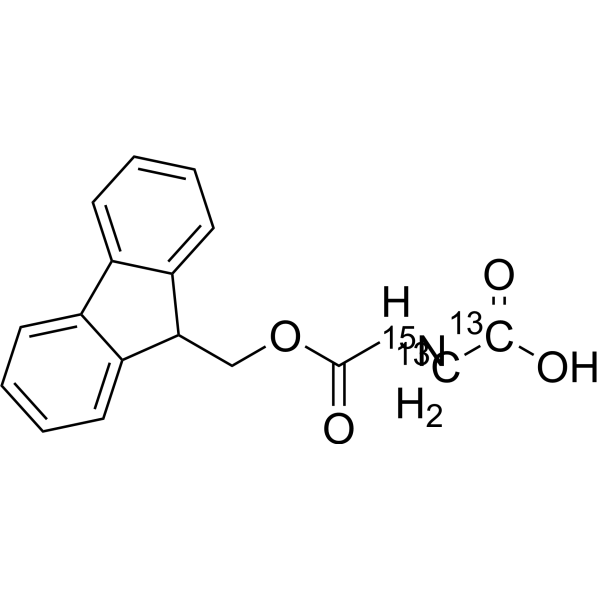
-
- HY-B1008S1
-
|
PABA-<sup>13sup>C<sub>6sub>; Vitamin Bx-<sup>13sup>C<sub>6sub>; Vitamin H1-<sup>13sup>C<sub>6sub>; p-Aminobenzoic acid-<sup>13sup>C<sub>6sub>
|
Endogenous Metabolite
|
Others
|
|
4-Aminobenzoic acid- 13C6 is the 13C-labeled 4-Aminobenzoic acid. 4-Aminobenzoic acid is an intermediate in the synthesis of folate by bacteria, plants, and fungi.
|
-
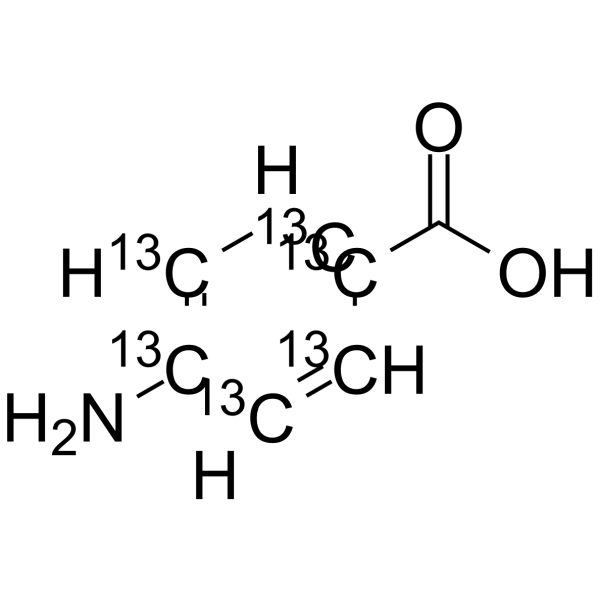
-
- HY-N0650S3
-
|
(-)-Serine-<sup>13sup>C<sub>3sub>,<sup>15sup>N,d<sub>3sub>; (S)-Serine-<sup>13sup>C<sub>3sub>,<sup>15sup>N,d<sub>3sub>
|
Isotope-Labeled Compounds
Endogenous Metabolite
|
Cancer
|
|
L-Serine- 13C3, 15N,d3 is the deuterium, 13C-, and 15-labeled L-Serine. L-Serine ((-)-Serine; (S)-Serine), one of the so-called non-essential amino acids, plays a central role in cellular proliferation.
|
-

-
- HY-B0141S4
-
|
β-Estradiol-<sup>13sup>C<sub>6sub>; E2-<sup>13sup>C<sub>6sub>; 17β-Estradiol-<sup>13sup>C<sub>6sub>; 17β-Oestradiol-<sup>13sup>C<sub>6sub>
|
Isotope-Labeled Compounds
Estrogen Receptor/ERR
Endogenous Metabolite
|
Endocrinology
Cancer
|
|
Estradiol- 13C6 is the 13C-labeled Estradiol. Estradiol is a steroid sex hormone vital to the maintenance of fertility and secondary sexual characteristics in females. Estradiol upregulates IL-6 expression through the estrogen receptor β (ERβ) pathway[1][2][3].
|
-

-
- HY-B0141S5
-
|
β-Estradiol-<sup>13sup>C<sub>2sub>; E2-<sup>13sup>C<sub>2sub>; 17β-Estradiol-<sup>13sup>C<sub>2sub>; 17β-Oestradiol-<sup>13sup>C<sub>2sub>
|
Isotope-Labeled Compounds
Estrogen Receptor/ERR
Endogenous Metabolite
|
Endocrinology
Cancer
|
|
Estradiol- 13C2 is the 13C-labeled Estradiol. Estradiol is a steroid sex hormone vital to the maintenance of fertility and secondary sexual characteristics in females. Estradiol upregulates IL-6 expression through the estrogen receptor β (ERβ) pathway[1][2][3].
|
-

-
- HY-16973S
-
|
A1443-<sup>13sup>C<sub>2sub>,<sup>15sup>N,d<sub>3sub>; AH252723-<sup>13sup>C<sub>2sub>,<sup>15sup>N,d<sub>3sub>
|
Isotope-Labeled Compounds
Parasite
|
Infection
|
|
Fluralaner- 13C2, 15N,d3 is the deuterium, 13C-, and 15-labeled Fluralaner. Fluralaner (INN) is a systemic insecticide and acaricide Fluralaner through potent blockage of GABA and L-glutamate gated chloride channels.
|
-

-
- HY-150712S
-
|
UTP-<sup>13sup>C<sub>9sub>,<sup>15sup>N<sub>2sub> dilithium; Uridine 5'-triphosphate-<sup>13sup>C<sub>9sub>,<sup>15sup>N<sub>2sub> dilithium
|
Isotope-Labeled Compounds
|
Others
|
|
Uridine triphosphate- 13C9, 15N5 dilithium is the 13C and 15N labeled Uridine triphosphate dilithium .
|
-
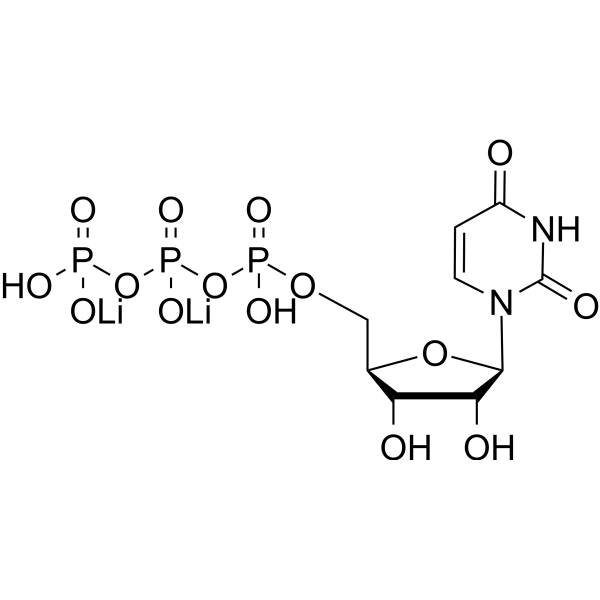
-
- HY-50896S1
-
|
CP-358774-<sup>13sup>C<sub>6sub>; NSC 718781-<sup>13sup>C<sub>6sub>; OSI-774-<sup>13sup>C<sub>6sub>
|
Isotope-Labeled Compounds
EGFR
Autophagy
|
Cancer
|
|
Erlotinib- 13C6 is a 13C-labeled Erlotinib. Erlotinib is a directly acting EGFR tyrosine kinase inhibitor, with an IC50 of 2 nM for human EGFR[1].
|
-

-
- HY-12008S1
-
|
CP-358774-<sup>13sup>C<sub>6sub> hydrochloride; NSC 718781-<sup>13sup>C<sub>6sub> hydrochloride; OSI-774-<sup>13sup>C<sub>6sub> hydrochloride
|
EGFR
Autophagy
|
Cancer
|
|
Erlotinib- 13C6 (hydrochloride) is the 13C labeled Erlotinib Hydrochloride[1]. Erlotinib Hydrochloride (CP-358774 Hydrochloride) inhibits purified EGFR kinase with an IC50 of 2 nM[2]. Erlotinib-13C6 (hydrochloride) is a click chemistry reagent, it contains an Alkyne group and can undergo copper-catalyzed azide-alkyne cycloaddition (CuAAc) with molecules containing Azide groups.
|
-

-
- HY-15027S2
-
|
Mesalamine-<sup>13sup>C<sub>6sub>; 5-ASA-<sup>13sup>C<sub>6sub>; Mesalazine-<sup>13sup>C<sub>6sub>
|
PPAR
PAK
NF-κB
Endogenous Metabolite
|
|
|
5-Aminosalicylic acid- 13C6 is the 13C labeled 5-Aminosalicylic Acid[1]. 5-Aminosalicylic acid (Mesalamine) acts as a specific PPARγ agonist and also inhibits p21-activated kinase 1 (PAK1) and NF-κB[2][3][4].
|
-

-
- HY-D0184S2
-
|
Deoxycytidine-<sup>15sup>N<sub>3sub>; Cytosine deoxyriboside-<sup>15sup>N<sub>3sub>; Deoxyribose cytidine-<sup>15sup>N<sub>3sub>
|
Endogenous Metabolite
|
Others
|
|
2'-Deoxycytidine- 15N3 is the 15N labeled 2'-Deoxycytidine[1]. 2'-Deoxycytidine, a deoxyribonucleoside, could inhibit biological effects of Bromodeoxyuridine (Brdu)[2].
|
-
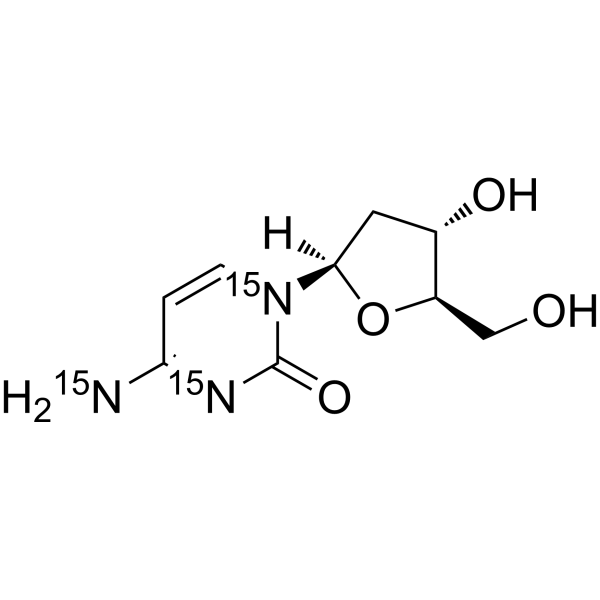
-
- HY-D0184S5
-
|
Deoxycytidine-<sup>13sup>C<sub>9sub>; Cytosine deoxyriboside-<sup>13sup>C<sub>9sub>; Deoxyribose cytidine-<sup>13sup>C<sub>9sub>
|
Isotope-Labeled Compounds
Endogenous Metabolite
|
Others
|
|
2'-Deoxycytidine- 13C9 (Deoxycytidine- 13C9; Cytosine deoxyriboside- 13C9; Deoxyribose cytidine- 13C9) is 13C-labeled 2'-Deoxycytidine (HY-D0184). 2'-Deoxycytidine, a deoxyribonucleoside, could inhibit biological effects of Bromodeoxyuridine (Brdu).
|
-
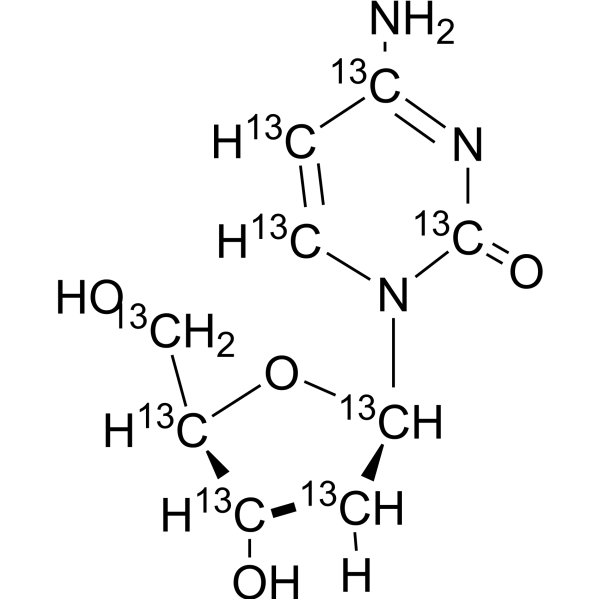
-
- HY-143704S
-
|
Mesalamine-<sup>13sup>C<sub>6sub> hydrochloride; 5-ASA-<sup>13sup>C<sub>6sub> hydrochloride; Mesalazine-<sup>13sup>C<sub>6sub> hydrochloride
|
PPAR
NF-κB
PAK
|
Metabolic Disease
|
|
5-Aminosalicylic acid-13C6 hydrochloride?(Mesalamine-13C6 hydrochloride; 5-ASA-13C6 hydrochloride; Mesalazine-13C6 hydrochloride) is the 13C labeled 5-Aminosalicylic Acidhydrochloride. 5-Aminosalicylic acid-13C6 hydrochloride?acts as a PPARγ agonist, and also inhibits p21-activated kinase 1 (PAK1) and NF-κB .
|
-

-
- HY-A0070AS1
-
|
Triiodothyronine-<sup>13sup>C<sub>9sub>,<sup>15sup>N; 3,3',5-Triiodo-L-thyronine-<sup>13sup>C<sub>9sub>,<sup>15sup>N; T3-<sup>13sup>C<sub>9sub>,<sup>15sup>N
|
Thyroid Hormone Receptor
Endogenous Metabolite
|
|
|
Liothyronine- 13C9, 15N is the 13C and 15N labeled Liothyronine[1]. Liothyronine is an active form of thyroid hormone. Liothyronine is a potent thyroid hormone receptors TRα and TRβ agonist with Kis of 2.33 nM for hTRα and hTRβ, respectively[2][3][4].
|
-

-
- HY-B0456S1
-
|
Vitamin B2-<sup>13sup>C<sub>4sub>,<sup>15sup>N<sub>2sub>-1; E101-<sup>13sup>C<sub>4sub>,<sup>15sup>N<sub>2sub>-1
|
Isotope-Labeled Compounds
Endogenous Metabolite
|
Others
|
|
Riboflavin-5-Phosphate- 13C4, 15N2-1 is the 13C-labeled and 15N-labeled Riboflavin. Riboflavin is an easily absorbed micronutrient with a key role in maintaining health in humans and other animals.
|
-
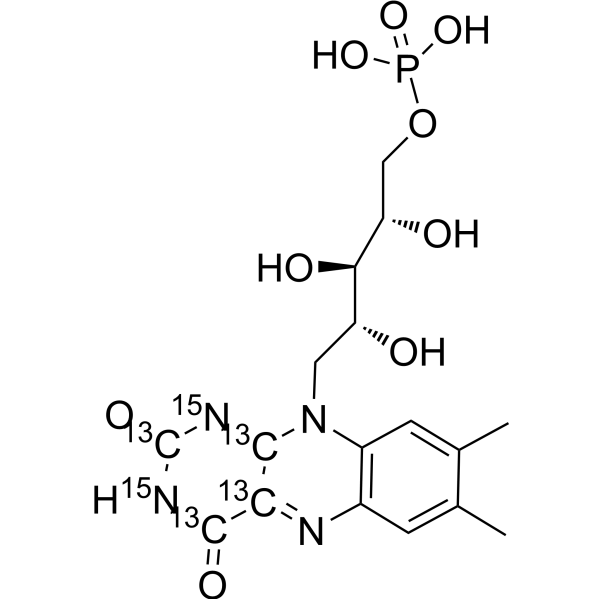
-
- HY-B0158S5
-
|
Cytosine β-D-riboside-<sup>13sup>C<sub>9sub>,<sup>15sup>N<sub>3sub>; Cytosine-1-β-D-ribofuranoside-<sup>13sup>C<sub>9sub>,<sup>15sup>N<sub>3sub>
|
Nucleoside Antimetabolite/Analog
Endogenous Metabolite
|
Neurological Disease
|
|
Cytidine- 13C9, 15N3 is the 13C and 15N labeled Cytidine[1]. Cytidine is a pyrimidine nucleoside and acts as a component of RNA. Cytidine is a precursor of uridine. Cytidine controls neuronal-glial glutamate cycling, affecting cerebral phospholipid metabolism, catecholamine synthesis, and mitochondrial function[2][3][4].
|
-

-
- HY-N5134S5
-
|
5'-GMP-<sup>13sup>C<sub>10sub>,<sup>15sup>N<sub>5sub> dilithium; 5'-guanosine monophosphate-<sup>13sup>C<sub>10sub>,<sup>15sup>N<sub>5sub> dilithium
|
Isotope-Labeled Compounds
Endogenous Metabolite
|
Metabolic Disease
|
|
5'-Guanylic acid- 13C10, 15N5 (5'-GMP- 13C10, 15N5 dilithium; 5'-guanosine monophosphate- 13C10, 15N5) dilithium is 13C and 15N-labeled 5'-Guanylic acid (HY-N5134). 5'-Guanylic acid (5'-GMP) is involved in several metabolic disorders, including the AICA-ribosiduria pathway, adenosine deaminase deficiency, adenine phosphoribosyltransferase deficiency (aprt), and the 2-hydroxyglutric aciduria pathway.
|
-

-
- HY-W009162S5
-
|
5'-Cytidylic acid-<sup>13sup>C<sub>9sub>,<sup>15sup>N<sub>3sub> dilithium; 5'-CMP-<sup>13sup>C<sub>9sub>,<sup>15sup>N<sub>3sub> dilithium
|
Isotope-Labeled Compounds
Endogenous Metabolite
|
Metabolic Disease
|
|
Cytidine 5′-monophosphate- 13C9, 15N3 (5'-Cytidylic acid- 13C9, 15N3 dilithium; 5'-CMP- 13C9, 15N3) dilithium is 13C and 15N-labeled Cytidine 5'-monophosphate (HY-W009162). Cytidine 5'-monophosphate (5'-Cytidylic acid) is a nucleotide which is used as a monomer in RNA. Cytidine 5'-monophosphate consists of the nucleobase cytosine, the pentose sugar ribose, and the phosphate group.
|
-

-
- HY-101400S2
-
|
dCTP-<sup>13sup>C<sub>9sub>,<sup>15sup>N<sub>3sub> dilithium; 2′-Deoxycytidine-5′-triphosphate-<sup>13sup>C<sub>9sub>,<sup>15sup>N<sub>3sub> dilithium
|
Isotope-Labeled Compounds
Nucleoside Antimetabolite/Analog
DNA/RNA Synthesis
Endogenous Metabolite
|
Metabolic Disease
|
|
Deoxycytidine triphosphate- 13C9, 15N3 (dCTP- 13C9, 15N3 dilithium; 2′-Deoxycytidine-5′-triphosphate- 13C9, 15N3) dilithium is 13C and 15N-labeled Deoxycytidine triphosphate (HY-101400). Deoxycytidine triphosphate (dCTP) is a nucleoside triphosphate that can be used for DNA synthesis. Deoxycytidine triphosphate has many applications, such as real-time PCR, cDNA synthesis, and DNA sequencing.
|
-

-
- HY-17413S1
-
|
Azidothymidine-<sup>13sup>C,d<sub>3sub>; AZT-<sup>13sup>C,d<sub>3sub>; ZDV-<sup>13sup>C,d<sub>3sub>
|
Isotope-Labeled Compounds
HIV
CRISPR/Cas9
|
Infection
|
|
Zidovudine- 13C,d3 is the 13C- and deuterium labeled Zidovudine. Zidovudine is a nucleoside reverse transcriptase inhibitor (NRTI), widely used to treat HIV infection. Zidovudine increases CRISPR/Cas9-mediated editing frequency. Zidovudine-13C,d3 is a click chemistry reagent, it contains an Azide group and can undergo copper-catalyzed azide-alkyne cycloaddition reaction (CuAAc) with molecules containing Alkyne groups. Strain-promoted alkyne-azide cycloaddition (SPAAC) can also occur with molecules containing DBCO or BCN groups.
|
-

-
- HY-106950S1
-
|
Diphosphofructose-<sup>13sup>C<sub>6sub> tetrasodium hydrate; Esafosfan-<sup>13sup>C<sub>6sub> tetrasodium hydrate; FDP-<sup>13sup>C<sub>6sub> tetrasodium hydrate
|
Endogenous Metabolite
|
Cardiovascular Disease
|
|
Fosfructose- 13C6 (tetrasodium hydrate) is the 13C labeled Fosfructose (HY-106950). Fosfructose is a cytoprotective natural sugar phosphate for the potential treatment of cardiovascular ischemia, sickle cell anemia and asthma[1].
|
-

-
- HY-B1431S1
-
|
Butyl parahydroxybenzoate-<sup>13sup>C<sub>6sub>; Butyl paraben-<sup>13sup>C<sub>6sub>; Butyl 4-hydroxybenzoate-<sup>13sup>C<sub>6sub>
|
Bacterial
Endogenous Metabolite
|
Infection
|
|
Butylparaben- 13C6 is the 13C labeled Butylparaben[1]. Butylparaben is an organic compound, has proven to be a highly successful antimicrobial preservative in cosmetics, also used in medication suspensions, and as a flavoring additive in food.
|
-

-
- HY-Y0271S
-
|
Carbamide-<sup>15sup>N<sub>2sub>; Carbonyldiamide-<sup>15sup>N<sub>2sub>
|
Endogenous Metabolite
|
Cardiovascular Disease
Cancer
|
|
Urea- 15N2 is the 15N-labeled Urea. Urea is a powerful protein denaturant via both direct and indirect mechanisms[1]. A potent emollient and keratolytic agent[2]. Used as a diuretic agent. Blood urea nitrogen (BUN) has been utilized to evaluate renal function[3]. Widely used in fertilizers as a source of nitrogen and is an important raw material for the chemical industry.
|
-

-
- HY-B0035S2
-
-

-
- HY-A0253S
-
-
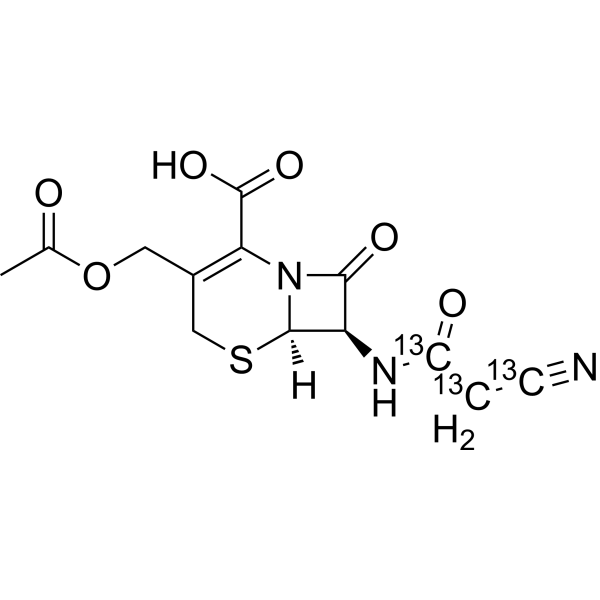
-
- HY-N1150S9
-
|
DThyd-<sup>15sup>N<sub>2sub>; NSC-<sup>15sup>N<sub>2sub>
|
DNA/RNA Synthesis
Endogenous Metabolite
Orthopoxvirus
|
Cancer
|
|
Thymidine- 15N2 is the 15N labeled Thymidine[1]. Thymidine, a specific precursor of deoxyribonucleic acid, is used as a cell synchronizing agent. Thymidine is a DNA synthesis inhibitor that can arrest cell at G1/S boundary, prior to DNA replication[2][3][4].
|
-

- HY-B0150S1
-
|
Niacinamide-<sup>15sup>N,<sup>13sup>C<sub>3sub>; Nicotinic acid amide-<sup>15sup>N,<sup>13sup>C<sub>3sub>
|
Endogenous Metabolite
Sirtuin
|
Neurological Disease
Cancer
|
|
Nicotinamide- 15N, 13C3 is the 13C-labeled and 15N-labeled Nicotinamide. Nicotinamide is a form of vitamin B3 that plays essential roles in cell physiology through facilitating NAD+ redox homeostasis and providing NAD+ as a substrate to a class of enzymes that catalyze non-redox reactions. Nicotinamide is an inhibitor of SIRT1.
|
-

- HY-N0733S5
-
-

- HY-13417S
-
|
Acadesine-<sup>13sup>C<sub>2sub>,<sup>15sup>N; AICA Riboside-<sup>13sup>C<sub>2sub>,<sup>15sup>N
|
Isotope-Labeled Compounds
|
Others
|
|
AICAR- 13C2, 15N (Acadesine- 13C2, 15N; AICA Riboside- 13C2, 15N)is the 13C and 15N labeledAICAR(HY-13417) . AICAR (Acadesine) is an adenosine analog and a AMPK activator. AICAR regulates the glucose and lipid metabolism, and inhibits proinflammatory cytokines and iNOS production. AICAR is also an autophagy, YAP and mitophagy inhibitor .
|
-

- HY-B0389S
-
-

- HY-B0389S22
-
|
Glucose-<sup>13sup>C<sub>2sub>,d<sub>2sub>; D-(+)-Glucose-<sup>13sup>C<sub>2sub>,d<sub>2sub>; Dextrose-<sup>13sup>C<sub>2sub>,d<sub>2sub>
|
Endogenous Metabolite
|
Metabolic Disease
Cancer
|
|
D-Glucose- 13C2,d2 is the deuterium and 13C labeled D-Glucose. D-Glucose (Glucose), a monosaccharide, is an important carbohydrate in biology. D-Glucose is a carbohydrate sweetener and critical components of the general metabolism, and serve as critical si
|
-

- HY-B0579S3
-
|
Cyclosporine A-<sup>13sup>C<sub>2sub>,d<sub>4sub>; Ciclosporin A-<sup>13sup>C<sub>2sub>,d<sub>4sub>; CsA-<sup>13sup>C<sub>2sub>,d<sub>4sub>
|
Isotope-Labeled Compounds
Calcineurin
|
Inflammation/Immunology
|
|
Cyclosporin A- 13C2,d4 (Cyclosporine A- 13C2,d4; Ciclosporin A- 13C2,d4) is a 13C labeled Cyclosporin A (HY-B0579) . Cyclosporin A (Cyclosporine A) is an immunosuppressant which binds to the cyclophilin and inhibits phosphatase activity of protein phosphatase 2B (PP2B/calcineurin) with an IC50 of 5 nM . Cyclosporin A also inhibits CD11a/CD18 adhesion .
|
-

- HY-B0139S
-
|
5-Fluorocytosine-<sup>13sup>C,15sup>N<sub>2sub>; NSC 103805-<sup>13sup>C,15sup>N<sub>2sub>; Ro 2-9915-<sup>13sup>C,15sup>N<sub>2sub>
|
Isotope-Labeled Compounds
|
Infection
|
|
Flucytosine- 13C, 15N2 (NSC 103805- 13C, 15N2; Ro 2-9915- 13C, 15N2) is a 13C- and 15N-labeled Flucytosine (HY-B0139).
|
-
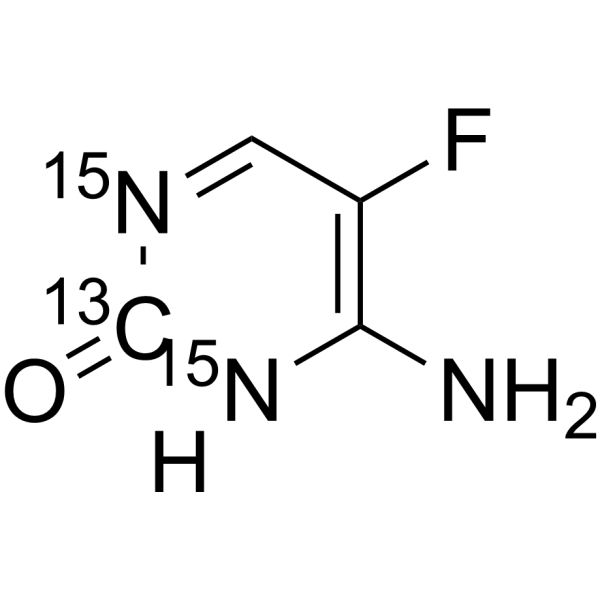
- HY-Y0721S
-
|
m-Bromofluorobenzene-<sup>13sup>C<sub>6sub>; m-Fluorobromobenzene-<sup>13sup>C<sub>6sub>; m-Fluorophenyl bromide-<sup>13sup>C<sub>6sub>
|
Isotope-Labeled Compounds
|
Others
|
|
3-Bromofluorobenzene- 13C6 is the 13C labeled 3-Bromofluorobenzene[1].
|
-
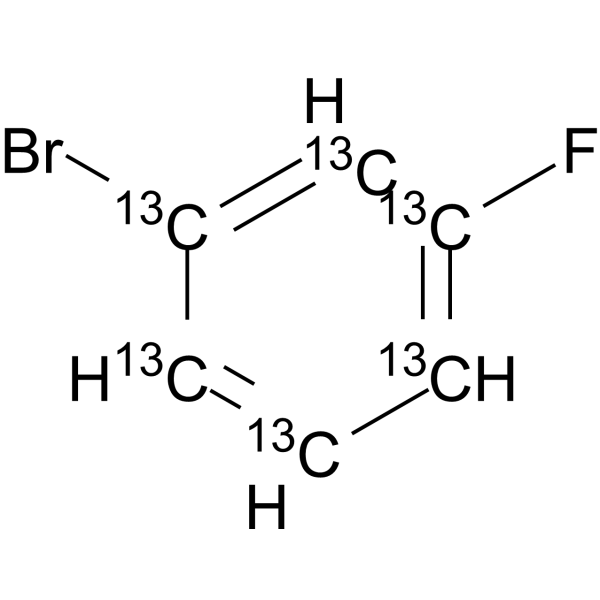
- HY-N0055S
-
|
3-O-Caffeoylquinic acid-<sub>13sub>C<sup>3sup>; Heriguard-<sub>13sub>C<sup>3sup>; NSC-407296-<sub>13sub>C<sup>3sup>
|
Isotope-Labeled Compounds
|
Cancer
|
|
Chlorogenic acid- 13C3 (Heriguard- 13C3; NSC-407296- 13C3) is 13C- and 15N-labeled Chlorogenic acid (HY-N0055). Chlorogenic acid is a major phenolic compound in Lonicera japonica Thunb.. It plays several important and therapeutic roles such as antioxidant activity, antibacterial, hepatoprotective, cardioprotective, anti-inflammatory, antipyretic, neuroprotective, anti-obesity, antiviral, anti-microbial, anti-hypertension .
|
-

- HY-B0178AS
-
|
Guanidinium-<sup>13sup>C,<sup>15sup>N<sub>3sub> (chloride); Aminoformamidine-<sup>13sup>C,<sup>15sup>N<sub>3sub> (hydrochloride)
|
Endogenous Metabolite
|
Metabolic Disease
|
|
Guanidine- 13C, 15N3 (hydrochloride)is the 13C-labeled and 15N-labeled Guanidine hydrochloride. Guanidine hydrochloride (Guanidinium chloride) a strong chaotrope, is also a strong denaturant of proteins[1][2].
|
-

- HY-N0650S5
-
|
(-)-Serine-<sup>13sup>C<sub>3sub>,<sup>15sup>N; (S)-Serine-<sup>13sup>C<sub>3sub>,<sup>15sup>N
|
Endogenous Metabolite
|
Cancer
|
|
L-Serine- 13C3, 15N is the 13C- and 15N-labeled L-Serine. L-Serine ((-)-Serine; (S)-Serine), one of the so-called non-essential amino acids, plays a central role in cellular proliferation.
|
-

- HY-13677S1
-
|
Mercaptopurine-<sup>13sup>C<sub>2sub>,<sup>15sup>N; 6-MP-<sup>13sup>C<sub>2sub>,<sup>15sup>N
|
Nucleoside Antimetabolite/Analog
Autophagy
Endogenous Metabolite
|
Cancer
|
|
6-Mercaptopurine- 13C2, 15N is the 13C- and 15N-labeled 6-Mercaptopurine. 6-Mercaptopurine is a purine analogue which acts as an antagonist of the endogenous purines and has been widely used as antileukemic agent and immunosuppressive agent.
|
-
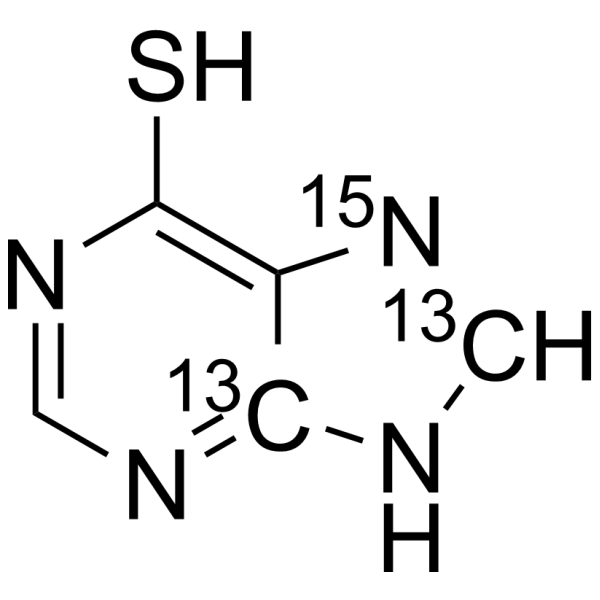
- HY-N0091S1
-
|
Purin-6-o-<sup>13sup>C,<sup>15sup>N<sub>2sub>; Sarcine-<sup>13sup>C,<sup>15sup>N<sub>2sub>
|
Bacterial
|
Infection
|
|
Hypoxanthine- 13C, 15N2 is a 15N-labeled and 13C-labled Furaltadone. Furaltadone, a nitrofuran agent, has the potential for the study in infections of chickens with salmonella enteritidis. Furaltadone is inhibitory and bactericidal in vitro for staphylococci
|
-
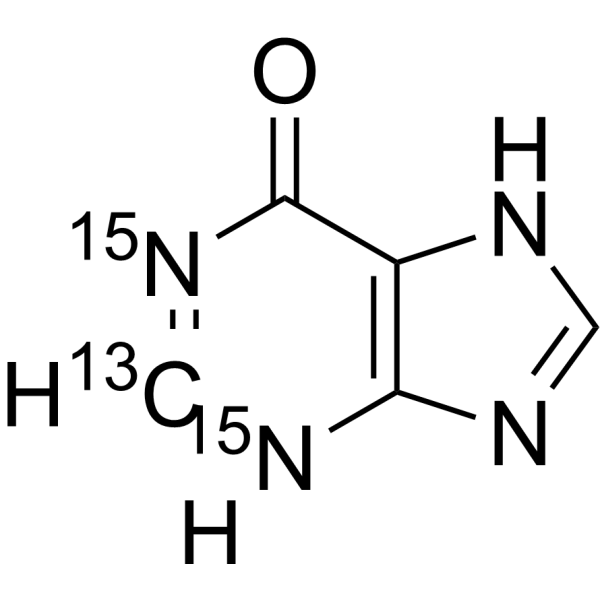
- HY-N0091S3
-
-
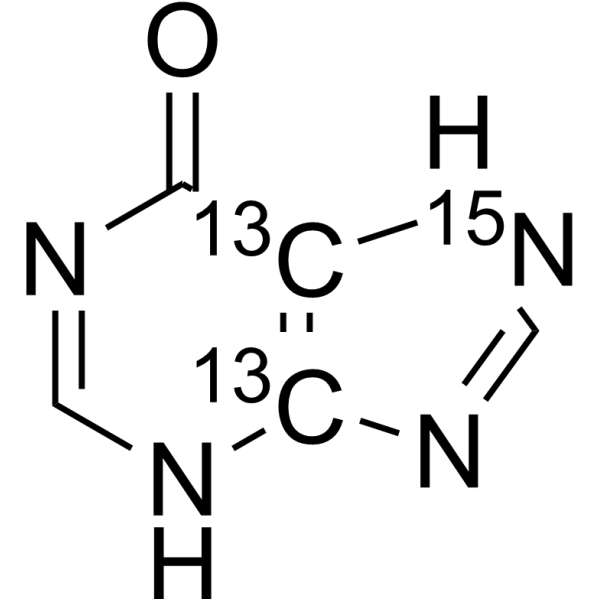
- HY-13623S1
-
|
BMS200475-<sup>13sup>C<sub>2sub>,<sup>15sup>N; SQ34676-<sup>13sup>C<sub>2sub>,<sup>15sup>N
|
Isotope-Labeled Compounds
|
Infection
|
|
Entecavir- 13C2, 15N (BMS200475- 13C2, 15N; SQ34676- 13C2, 15N) is a 13C- and 15N-labeled Entecavir (HY-13623). Entecavir (SQ 34676; BMS 200475) is a potent and selective inhibitor of HBV, with an EC50 of 3.75 nM in HepG2 cell.
|
-

- HY-B0234S
-
|
E1-<sup>13sup>C<sub>3sub>; Oestrone-<sup>13sup>C<sub>3sub>
|
Estrogen Receptor/ERR
Endogenous Metabolite
|
Endocrinology
Cancer
|
|
Estrone- 13C3 is the 13C-labeled Estrone. Estrone (E1) is a natural estrogenic hormone. Estrone is the main representative of the endogenous estrogens and is produced by several tissues, especially adipose tissue. Estrone is the result of the process of aromatization of androstenedione that occurs in fat cells[1][2].
|
-

- HY-40354S
-
|
Tasocitinib-<sup>13sup>C<sub>3sub>; CP-690550-<sup>13sup>C<sub>3sub>
|
JAK
Apoptosis
|
Inflammation/Immunology
Cancer
|
|
Tofacitinib- 13C3 is the 13C-labeled Tofacitinib. Tofacitinib is an orally available JAK3/2/1 inhibitor with IC50s of 1, 20, and 112 nM, respectively.
|
-

- HY-N0623S2
-
-

- HY-N0623S8
-
|
Tryptophan-<sup>15sup>N<sub>2sub>; Tryptophane-<sup>15sup>N<sub>2sub>
|
Endogenous Metabolite
|
Metabolic Disease
|
|
L-Tryptophan- 15N2 is the 15N-labeled L-Tryptophan. L-Tryptophan (Tryptophan) is an essential amino acid that is the precursor of serotonin, melatonin, and vitamin B3[1].
|
-

- HY-B0150S2
-
|
Niacinamide-<sup>13sup>C<sub>6sub>; Nicotinic acid amide-<sup>13sup>C<sub>6sub>
|
Endogenous Metabolite
Sirtuin
|
Neurological Disease
Cancer
|
|
Nicotinamide- 13C6 is the 13C-labeled Nicotinamide. Nicotinamide is a form of vitamin B3 that plays essential roles in cell physiology through facilitating NAD+ redox homeostasis and providing NAD+ as a substrate to a class of enzymes that catalyze non-redox reactions. Nicotinamide is an inhibitor of SIRT1.
|
-

- HY-B0234S3
-
|
E1-<sup>13sup>C<sub>2sub>; Oestrone-<sup>13sup>C<sub>2sub>
|
Isotope-Labeled Compounds
Estrogen Receptor/ERR
Endogenous Metabolite
|
Endocrinology
Cancer
|
|
Estrone- 13C2 is the 13C-labeled Estrone. Estrone (E1) is a natural estrogenic hormone. Estrone is the main representative of the endogenous estrogens and is produced by several tissues, especially adipose tissue. Estrone is the result of the process of aromatization of androstenedione that occurs in fat cells[1][2].
|
-

- HY-B0213S1
-
|
Sulfametoxydiazine-<sup>13sup>C<sub>6sub>; 5-Methoxysulfadiazine-<sup>13sup>C<sub>6sub>
|
Isotope-Labeled Compounds
Antibiotic
Bacterial
|
Infection
|
|
Sulfameter- 13C6 is the 13C6 labeled Sulfameter. Sulfameter (Sulfametoxydiazine; 5-Methoxysulfadiazine) is an effective long-acting sulfonamide antibiotic with antibacterial activities. Sulfameter can be used for the research of urinary tract infections and lepriasis.
|
-

- HY-B1331S1
-
|
Cyromazin-<sup>13sup>C<sub>3sub>; CGA-72662-<sup>13sup>C<sub>3sub>
|
Isotope-Labeled Compounds
Endogenous Metabolite
|
Neurological Disease
|
|
Cyromazine- 13C3 is the 13C3 labeled Cyromazine. Cyromazine is a triazine insect growth regulator used as an insecticide and an acaricide. It is a cyclopropyl derivative of melamine. Cyromazine works by affecting the nervous system of the immature larval stages of certain insects.
|
-
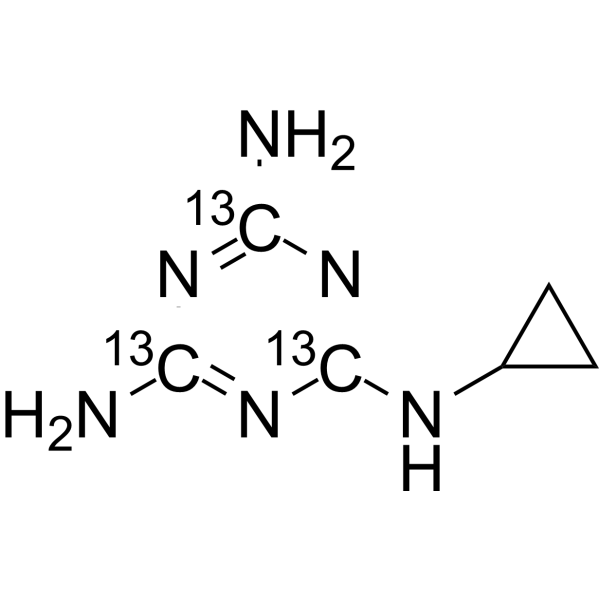
- HY-N0097S3
-
|
DL-Guanosine-<sup>15sup>N<sub>5sub>; Vernine-<sup>15sup>N<sub>5sub>
|
HSV
Endogenous Metabolite
|
Infection
|
|
Guanosine- 15N5 is the 15N labeled Guanosine[1]. Guanosine (DL-Guanosine) is a purine nucleoside comprising guanine attached to a ribose (ribofuranose) ring via a β-N9-glycosidic bond. Guanosine possesses anti-HSV activity[2].
|
-

- HY-N0378S2
-
|
Mannitol-<sup>13sup>C<sub>6sub>; Mannite-<sup>13sup>C<sub>6sub>
|
Apoptosis
Endogenous Metabolite
|
|
|
D-Mannitol- 13C6 is the 13C labeled D-Mannitol[1]. D-Mannitol is an osmotic diuretic agent and a weak renal vasodilator[2][3][4].
|
-

- HY-N1150S11
-
|
DThyd-<sup>13sup>C<sub>10sub>; NSC 21548-<sup>13sup>C<sub>10sub>
|
Isotope-Labeled Compounds
DNA/RNA Synthesis
Endogenous Metabolite
Orthopoxvirus
|
Cancer
|
|
Thymidine- 13C10 (DThyd- 13C10; NSC 21548- 13C10) is 13C-labeled Thymidine (HY-N1150). Thymidine, a specific precursor of deoxyribonucleic acid, is used as a cell synchronizing agent. Thymidine is a DNA synthesis inhibitor that can arrest cell at G1/S boundary, prior to DNA replication.
|
-

- HY-100196S1
-
|
PQQ-<sup>13sup>C<sub>3sub> sodium; Methoxatin-<sup>13sup>C<sub>3sub> sodium
|
Endogenous Metabolite
|
Inflammation/Immunology
|
|
Pyrroloquinoline quinone-13C3 (sodium) is an isotope of Pyrroloquinoline quinone. Pyrroloquinoline quinone (PQQ), a redox co-factor, is an anionic, redox-cycling orthoquinone. Pyrroloquinoline quinone is isolated from cultures of methylotropic bacteria and tissues of mammals. Pyrroloquinoline quinone is an essential nutrient for mammals and is important for immune function .
|
-

- HY-N0097S4
-
|
DL-Guanosine-<sup>13sup>C<sub>10sub>; Vernine-<sup>13sup>C<sub>10sub>
|
Isotope-Labeled Compounds
Endogenous Metabolite
HSV
|
Infection
|
|
Guanosine- 13C10 is the 13C labeled Guanosine (HY-N0097). Guanosine is a purine nucleoside comprising guanine attached to a ribose (ribofuranose) ring via a β-N9-glycosidic bond. Guanosine possesses anti-HSV activity .
|
-

- HY-Y0589S
-
|
3-Carboxybenzonitrile-<sup>13sup>C<sub>6sub>; 3-Cyanobenzoic acid-<sup>13sup>C<sub>6sub>; m-Carboxybenzonitrile-<sup>13sup>C<sub>6sub>
|
Isotope-Labeled Compounds
|
Others
|
|
m-Cyanobenzoic acid- 13C6 is the 13C labeled m-Cyanobenzoic acid[1].
|
-
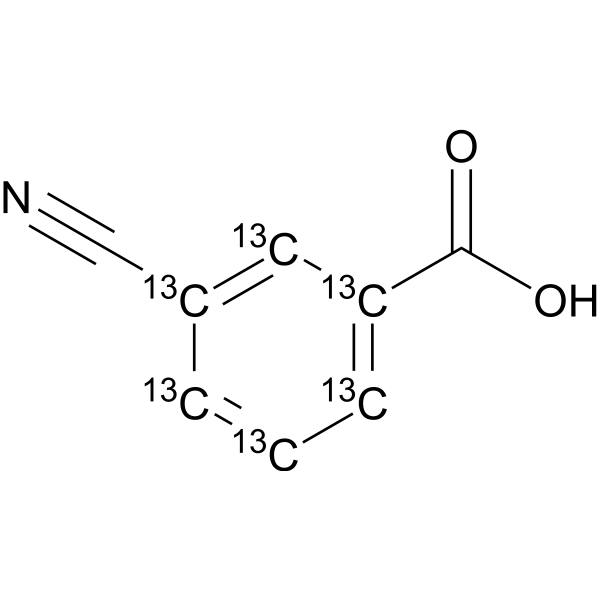
- HY-13756S
-
|
FK506-<sup>13sup>C,d<sub>2sub>; Fujimycin-<sup>13sup>C,d<sub>2sub>; FR900506-<sup>13sup>C,d<sub>2sub>
|
Phosphatase
FKBP
Bacterial
Autophagy
Antibiotic
|
Infection
Inflammation/Immunology
Cancer
|
|
Tacrolimus- 13C,d2 is a 13C-labeled and deuterium labeled Tacrolimus. Tacrolimus (FK506), a macrocyclic lactone, binds to FK506 binding protein (FKBP) to form a complex. Tacrolimus inhibits calcineurin phosphatase, which inhibits T-lymphocyte signal transduction and IL-2 transcription. Immunosuppressive properties[1].
|
-

- HY-B0389S18
-
|
Glucose-<sup>13sup>C<sub>3sub>-1; D-(+)-Glucose-<sup>13sup>C<sub>3sub>-1; Dextrose-<sup>13sup>C<sub>3sub>-1
|
Endogenous Metabolite
|
Metabolic Disease
|
|
D-Glucose- 13C3-1 is the 13C labeled D-Glucose. D-Glucose (Glucose), a monosaccharide, is an important carbohydrate in biology. D-Glucose is a carbohydrate sweetener and critical components of the general metabolism, and serve as critical signaling molecules in relation to both cellular metabolic status and biotic and abiotic stress response[1].
|
-

- HY-B0389S15
-
|
Glucose-<sup>13sup>C<sub>2sub>-4; D-(+)-Glucose-<sup>13sup>C<sub>2sub>-4; Dextrose-<sup>13sup>C<sub>2sub>-4
|
Endogenous Metabolite
|
Metabolic Disease
|
|
D-Glucose- 13C2-4 is the 13C labeled D-Glucose. D-Glucose (Glucose), a monosaccharide, is an important carbohydrate in biology. D-Glucose is a carbohydrate sweetener and critical components of the general metabolism, and serve as critical signaling molecules in relation to both cellular metabolic status and biotic and abiotic stress response[1].
|
-

- HY-B0389S9
-
|
Glucose-<sup>13sup>C<sub>3sub>-2; D-(+)-Glucose-<sup>13sup>C<sub>3sub>-2; Dextrose-<sup>13sup>C<sub>3sub>-2
|
Isotope-Labeled Compounds
Endogenous Metabolite
|
Metabolic Disease
|
|
D-Glucose- 13C3-2 is the 13C labeled D-Glucose. D-Glucose (Glucose), a monosaccharide, is an important carbohydrate in biology. D-Glucose is a carbohydrate sweetener and critical components of the general metabolism, and serve as critical signaling molecules in relation to both cellular metabolic status and biotic and abiotic stress response[1].
|
-

- HY-14855S
-
|
TR 700-<sup>13sup>C,d<sub>3sub>; Torezolid-<sup>13sup>C,d<sub>3sub>; DA-7157-<sup>13sup>C,d<sub>3sub>
|
Isotope-Labeled Compounds
Bacterial
Antibiotic
|
Infection
|
|
Tedizolid- 13C,d3 is the 13C- and deuterium labeled Tedizolid. Tedizolid (TR 700; Torezolid; DA-7157) is a novel oxazolidinone, acting through inhibition of bacterial protein synthesis by binding to 23S ribosomal RNA (rRNA) of the 50S subunit of the ribosome.
|
-

- HY-B0457S2
-
|
Chlorimipramine-<sup>13sup>C,d<sub>3sub> hydrochloride; G-34586-<sup>13sup>C,d<sub>3sub> hydrochloride; NSC-169865-<sup>13sup>C,d<sub>3sub> hydrochloride
|
Isotope-Labeled Compounds
Serotonin Transporter
|
Neurological Disease
|
|
Clomipramine- 13C,d3 (hydrochloride) is the 13C- and deuterium labeled Clomipramine (hydrochloride). Clomipramine (Chlorimipramine) hydrochloride is a potent 5-HT reuptake blocker with the IC50 value of 1.5 nM. Clomipramine hydrochloride is a tricyclic antidepressant that can be used for the research of depression and obsessive compulsive disorder (OCD)[1].
|
-

- HY-B0389S21
-
|
Glucose-<sup>13sup>C,d<sub>2sub>; D-(+)-Glucose-<sup>13sup>C,d<sub>2sub>; Dextrose-<sup>13sup>C,d<sub>2sub>
|
Endogenous Metabolite
|
Metabolic Disease
Cancer
|
|
D-Glucose- 13C,d2 is the deuterium and 13C labeled D-Glucose. D-Glucose (Glucose), a monosaccharide, is an important carbohydrate in biology. D-Glucose is a carbohydrate sweetener and critical components of the general metabolism, and serve as critical sig
|
-

- HY-B0389S25
-
|
Glucose-<sup>13sup>C,d<sub>1sub>; D-(+)-Glucose-<sup>13sup>C,d<sub>1sub>; Dextrose-<sup>13sup>C,d<sub>1sub>
|
Endogenous Metabolite
|
Metabolic Disease
Cancer
|
|
D-Glucose- 13C,d is the deuterium and 13C labeled D-Glucose. D-Glucose (Glucose), a monosaccharide, is an important carbohydrate in biology. D-Glucose is a carbohydrate sweetener and critical components of the general metabolism, and serve as critical sig
|
-

- HY-Y1298S
-
|
Acetoacetate methyl ester-<sup>13sup>C<sub>4sub>; Methyl 3-oxobutanoate-<sup>13sup>C<sub>4sub>; Methyl acetoacetate-<sup>13sup>C<sub>4sub>
|
Endogenous Metabolite
|
Others
|
|
Methyl acetylacetate- 13C4 is an isotopically labeled compound. Methyl acetylacetate- 13C4 can be used for various biochemical studies[1].
|
-
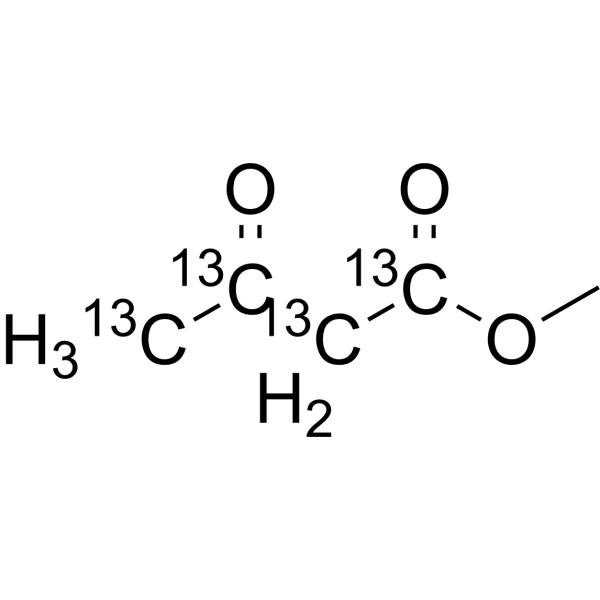
- HY-N0545S
-
|
Sodium taurocholate-<sup>13sup>C<sub>2sub>,<sup>15sup>N; N-Choloyltaurine-<sup>13sup>C<sub>2sub>,<sup>15sup>N (sodium)
|
VEGFR
Endogenous Metabolite
|
Inflammation/Immunology
|
|
Taurocholic acid- 13C2, 15N (sodium) is the 13C- and 15N- labeled Taurocholic acid (sodium).
|
-
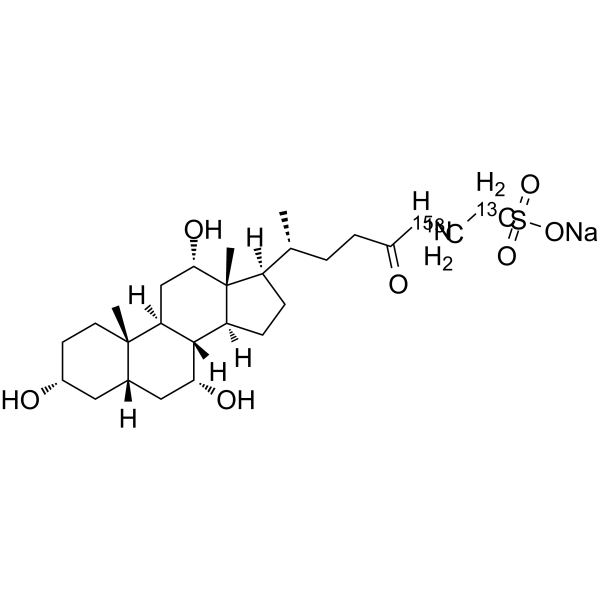
- HY-14291S2
-
|
LAF237-<sup>13sup>C<sub>5sub>,<sup>15sup>N; NVP-LAF 237-<sup>13sup>C<sub>5sub>,<sup>15sup>N
|
Isotope-Labeled Compounds
|
Metabolic Disease
|
|
Vildagliptin- 13C5, 15N (LAF237- 13C5, 15N; NVP-LAF 237- 13C5, 15N) is a 13C- and 15N-labeled Vildagliptin (HY-14291). Vildagliptin (LAF237) is a potent, stable, selective dipeptidyl peptidase IV (DPP-IV) inhibitor with an IC50 of 3.5 nM in human Caco-2 cells. Vildagliptin possesses excellent oral bioavailability and potent antihyperglycemic activity .
|
-

- HY-N1393S
-
|
NSC 3778-<sup>13sup>C<sub>6sub>; O-Methylsalicylic acid-<sup>13sup>C<sub>6sub>; Salicylic acid methyl ether-<sup>13sup>C<sub>6sub>
|
Isotope-Labeled Compounds
Endogenous Metabolite
|
Cancer
|
|
2-Methoxybenzoic acid- 13C6 is the 13C-labeled 2-Methoxybenzoic acid. 2-Methoxybenzoic acid (NSC 3778) is used as an internal standard of salicylic acid and its putative biosynthetic precursors in cucumber leaves. Another known use is in the synthesis of Benextramine.
|
-

- HY-A0042S1
-
|
CGP 33101-<sup>15sup>N,d<sub>2sub>; E 2080-<sup>15sup>N,d<sub>2sub>; RUF 331-<sup>15sup>N,d<sub>2sub>
|
Isotope-Labeled Compounds
|
Neurological Disease
|
|
Rufinamide- 15N,d2 is the deuterium and 15N labeled Rufinamide[1]. Rufinamide is a new antiepileptic agent that differs structurally from other antiepileptic agents and is approved as adjunctive therapy for Lennox-Gastaut syndrome (LGS)[2][3].
|
-

- HY-N0098S2
-
|
p-Vanillin-<sup>13sup>C<sub>6sub>; m-Methoxy-p-hydroxybenzaldehyde-<sup>13sup>C<sub>6sub>; p-Hydroxy-m-methoxybenzaldehyde-<sup>13sup>C<sub>6sub>
|
Endogenous Metabolite
|
Others
|
|
Vanillin- 13C6 is the 13C labeled Vanillin[1]. Vanillin (p-Vanillin) is a single molecule extracted from vanilla beans and also a popular odor used widely in perfume, food and medicine[2][3].
|
-
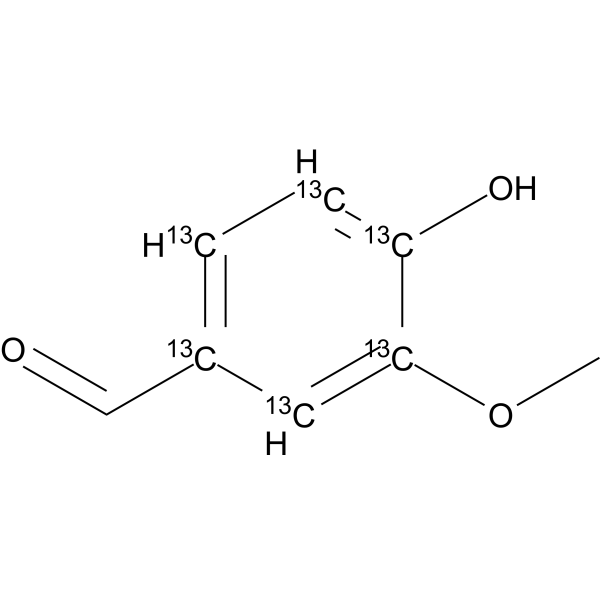
- HY-16561S1
-
|
trans-Resveratrol-<sup>13sup>C<sub>6sub>; SRT501-<sup>13sup>C<sub>6sub>
|
Isotope-Labeled Compounds
IKK
Autophagy
Mitophagy
Sirtuin
Apoptosis
Bacterial
Fungal
Antibiotic
Keap1-Nrf2
|
Infection
Inflammation/Immunology
Cancer
|
|
Resveratrol- 13C6 is the 13C-labeled Resveratrol. Resveratrol (trans-Resveratrol; SRT501), a natural polyphenolic phytoalexin that possesses anti-oxidant, anti-inflammatory, cardioprotective, and anti-cancer properties. Resveratrol (SRT 501) has a wide spectrum of targets including mTOR, JAK, β-amyloid, Adenylyl cyclase, IKKβ, DNA polymerase. Resveratrol also is a specific SIRT1 activator[1][2][3][4]. Resveratrol is a potent pregnane X receptor (PXR) inhibitor[5]. Resveratrol is an Nrf2 activator, ameliorates aging-related progressive renal injury in mice model[6]. Resveratrol increases production of NO in endothelial cells[7].
|
-

- HY-18341S1
-
-

- HY-N0650S
-
|
(-)-Serine-<sup>13sup>C<sub>3sub>; (S)-Serine-<sup>13sup>C<sub>3sub>
|
Endogenous Metabolite
|
Cancer
|
|
L-Serine- 13C3 is the 13C-labeled L-Serine. L-Serine ((-)-Serine; (S)-Serine), one of the so-called non-essential amino acids, plays a central role in cellular proliferation.
|
-

- HY-N0682S3
-
|
Pyridoxol-<sup>13sup>C<sub>4sub> hydrochloride; Vitamin B6-<sup>13sup>C<sub>4sub> hydrochloride
|
Isotope-Labeled Compounds
Endogenous Metabolite
Keap1-Nrf2
|
Neurological Disease
|
|
Pyridoxine- 13C4 (hydrochloride) is the 13C-labeled Pyridoxine (hydrochloride). Pyridoxine hydrochloride (Pyridoxol; Vitamin B6) is a pyridine derivative. Pyridoxine (Pyridoxol; Vitamin B6) exerts antioxidant effects in cell model of Alzheimer's disease via the Nrf-2/HO-1 pathway.
|
-

- HY-N0091S2
-
-
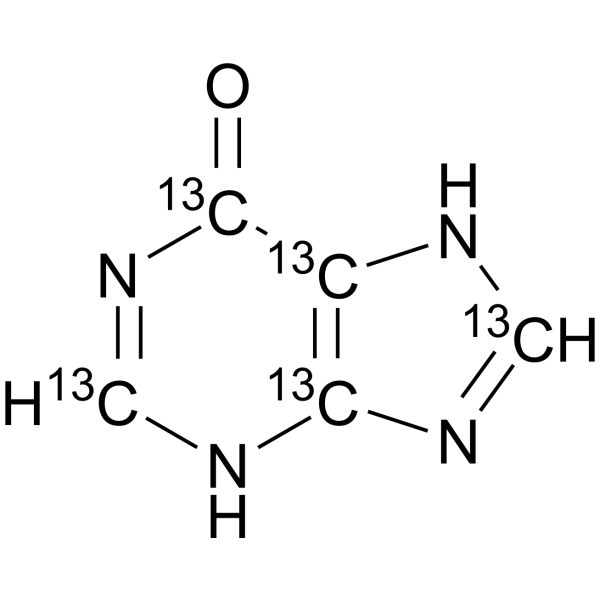
- HY-N0684S3
-
|
Phylloquinone-<sup>13sup>C<sub>6sub>; Phytomenadione-<sup>13sup>C<sub>6sub>
|
Endogenous Metabolite
|
Cardiovascular Disease
|
|
Vitamin K1- 13C6 is the 13C-labeled Vitamin K1. Vitamin K1 a naturally occurring vitamin required for blood coagulation and bone and vascular metabolism.
|
-

- HY-B0495S4
-
|
LTG-<sup>13sup>C<sub>3sub>; BW430C-<sup>13sup>C<sub>3sub>
|
Sodium Channel
Autophagy
|
Neurological Disease
|
|
Lamotrigine- 13C3 is the 13C-labeled Lamotrigine. Lamotrigine (BW430C) is a potent and orally active anticonvulsant or antiepileptic agent. Lamotrigine selectively blocks voltage-gated Na+ channels, stabilizing presynaptic neuronal membranes and inhibiting glutamate release. Lamotrigine can be used for the research of epilepsy, focal seizure, et al[1][2].
|
-

| Cat. No. |
Product Name |
Chemical Structure |
-
- HY-D0844S
-
1 Publications Verification
|
|
Glutathione oxidized- 13C4, 15N2 is the 13C and 15N labeled Glutathione oxidized (HY-D0844). Glutathione oxidized is produced by the oxidation of glutathione. Detoxification of reactive oxygen species is accompanied by production of glutathione oxidized. Glutathione oxidized can be used for the research of sickle cells and erythrocytes[1][2].
|
-

-
- HY-D0184S3
-
|
|
|
2'-Deoxycytidine- 13C9, 15N3 (Deoxycytidine- 13C9, 15N3; Cytosine deoxyriboside- 13C9, 15N3; Deoxyribose cytidine- 13C9, 15N3) is 13C and 15N-labeled 2'-Deoxycytidine (HY-D0184). 2'-Deoxycytidine, a deoxyribonucleoside, could inhibit biological effects of Bromodeoxyuridine (Brdu).
|
-

-
- HY-N1150S8
-
|
|
|
Thymidine- 13C10, 15N2 is the 13C and 15N labeled Thymidine[1]. Thymidine, a specific precursor of deoxyribonucleic acid, is used as a cell synchronizing agent. Thymidine is a DNA synthesis inhibitor that can arrest cell at G1/S boundary, prior to DNA replication[2][3][4].
|
-

-
- HY-N0623S4
-
|
|
|
L-Tryptophan- 13C11, 15N2 is the 13C- and 15N-labeled L-Tryptophan. L-Tryptophan (Tryptophan) is an essential amino acid that is the precursor of serotonin, melatonin, and vitamin B3[1].
|
-

-
- HY-N0097S6
-
|
|
|
Guanosine- 13C10, 15N5 is the 13C and 15N labeled Guanosine (HY-N0097). Guanosine (DL-Guanosine) is a purine nucleoside comprising guanine attached to a ribose (ribofuranose) ring via a β-N9-glycosidic bond. Guanosine possesses anti-HSV activity .
|
-

-
- HY-A0061S
-
|
|
|
Trifluridine- 13C, 15N2 is the 13C and 15N labeled Trifluridine[1]. Trifluridine (Trifluorothymidine;5-Trifluorothymidine;TFT) is an irreversible thymidylate synthase inhibitor, and thereby suppresses DNA synthesis. Trifluridine is an antiviral agent for herpes simplex virus (HSV) infection. Trifluorothymidine also has anti-orthopoxvirus activity[2].
|
-

-
- HY-108213S
-
|
|
|
Inosinic acid- 13C10, 15N4 dilithium (5'-IMP-13C10,15N4 (dilithium); IMP-13C10,15N4 (dilithium); Inosine 5'-(dihydrogen phosphate)-13C10,15N4 (dilithium)) is 13C- and 15N-labeled Inosinic acid (HY-108213). Inosinic acid is an endogenous metabolite .
|
-

-
- HY-N0091S
-
|
|
|
Hypoxanthine- 13C5, 15N4 is a 15N-labeled and 13C-labled Dansyl chloride.
|
-

-
- HY-B1118S1
-
|
|
|
Secnidazole- 13C2, 15N2 is the 13C2, 15N2 labeled Secnidazole. Secnidazole (RP-14539;PM-185184) is an orally active azole antibiotic with a longer half-life than metronidazole (HY-B0318). Secnidazole is against the vaginosis-associated bacteria and has the potential for bacterial vaginosis research.
|
-

-
- HY-17563S1
-
|
|
|
2'-Deoxyguanosine- 13C10, 15N5 (Deoxyguanosine- 13C10, 15N5; Guanine deoxyriboside- 13C10, 15N5) is a 13C- and 15N-labeled 2'-Deoxyguanosine (HY-17563).
|
-

-
- HY-B0456S
-
|
|
|
Riboflavin- 13C4, 15N2is the 13C-labeled and 15N-labeled Riboflavin. Riboflavin is an easily absorbed micronutrient with a key role in maintaining health in humans and other animals.
|
-

-
- HY-Y0219S
-
|
|
|
NSC 83128- 13C2, 15N3 is the 13C and 15N labeled NSC 83128[1].
|
-

-
- HY-107372S
-
|
|
|
Uridine triphosphate- 13C9, 15N2 (sodium) is a labeled Uridine triphosphate sodium. Uridine triphosphate sodium can be used in nucleic acid synthesis.
|
-

-
- HY-W011240S1
-
|
|
|
Hydroflumethiazide- 15N2, 13C,d2 is the 13C- and 15N-labeled Hydroflumethiazide[1].
|
-

-
- HY-B0152S2
-
|
|
|
Adenine- 13C5,15C5 (6-Aminopurine- 13C5,15C5; Vitamin B4- 13C5,15C5) is 13C-labeled Adenine (HY-B0152). Adenine (6-Aminopurine), a purine, is one of the four nucleobases in the nucleic acid of DNA. Adenine acts as a chemical component of DNA and RNA. Adenine also plays an important role in biochemistry involved in cellular respiration, the form of both ATP and the cofactors (NAD and FAD), and protein synthesis.
|
-

-
- HY-A0161S
-
|
|
|
Chlophedianol- 13C6 is the 13C labeled Chlophedianol (HY-A0161). Chlophedianol is an orally active and potent antitussive agent. Chlophedianol can be used for the research of acute cough due to upper respiratory tract infections (URIs)[1][2][3].
|
-

-
- HY-N0667S2
-
|
|
|
L-Asparagine- 15N2 (monohydrate) is the 15N-labeled L-Asparagine. L-Asparagine ((-)-Asparagine) is a non-essential amino acid that is involved in the metabolic control of cell functions in nerve and brain tissue.
|
-

-
- HY-N0667S3
-
|
|
|
L-Asparagine- 13C4 (monohydrate) is the 13C-labeled L-Asparagine. L-Asparagine ((-)-Asparagine) is a non-essential amino acid that is involved in the metabolic control of cell functions in nerve and brain tissue.
|
-

-
- HY-N0898S
-
|
|
|
Catechin- 13C3 is the 13C-labeled Catechin. Catechin ((+)-Catechin) inhibits cyclooxygenase-1 (COX-1) with an IC50 of 1.4 μM.
|
-

-
- HY-13458S1
-
|
|
|
Droxidopa- 13C2, 15N (hydrochloride) is deuterium labeled Droxidopa. Droxidopa(L-DOPS), the mixture of Droxidopa (w/w80%) and Pharmaceutical starch (w/w20%), acts as a proagent to the neurotransmitters norepinephrine (noradrenaline) and epinephrine (adrenaline); Droxidopa(L-DOPS) is capable of crossing the protective blood–brain barrier[1][2].
|
-

-
- HY-66005S4
-
|
|
|
Acetaminophen- 13C2, 15N is the 13C and 15N labeled Acetaminophen[1]. Acetaminophen (Paracetamol) is a selective cyclooxygenase-2 (COX-2) inhibitor with an IC50 of 25.8 μM;is a widely used antipyretic and analgesic agent[2][3][4]. Acetaminophen is a potent hepatic N-acetyltransferase 2 (NAT2) inhibitor[5].
|
-

-
- HY-10572S1
-
|
|
|
Efavirenz- 13C6 is the 13C-labeled Efavirenz. Efavirenz (DMP 266) is a potent inhibitor of the wild-type HIV-1 reverse transcriptase with a Ki of 2.93 nM and exhibits an IC95 of 1.5 nM for the inhibition of HIV-1 replicative spread in cell culture[1].
|
-

-
- HY-B0389A
-
3 Publications Verification
|
|
D-Glucose- 13C6 is a stable isotope-labeled counterpart of D-glucose (HY-B0389). D-Glucose- 13C6 can be used as a metabolic tracer to trace glucose-related synthetic catabolism or as synthesis ingredient, minimal media reagent, and internal standard .
|
-

-
- HY-B0389S14
-
|
|
|
D-Glucose- 13C2 is the 13C labeled D-Glucose. D-Glucose (Glucose), a monosaccharide, is an important carbohydrate in biology. D-Glucose is a carbohydrate sweetener and critical components of the general metabolism, and serve as critical signaling molecules in relation to both cellular metabolic status and biotic and abiotic stress response[1].
|
-

-
- HY-Y1250S6
-
|
|
|
Fmoc-Gly-OH- 13C2, 15N is a 15N-labeled and 13C-labled Crystal Violet. Crystal violet (Basic Violet 3) is a triarylmethane dye. Crystal Violet (Gentian Violet) has antiviral effects against H1N1 and also has prominent bactericidal activities.
|
-

-
- HY-B1008S1
-
|
|
|
4-Aminobenzoic acid- 13C6 is the 13C-labeled 4-Aminobenzoic acid. 4-Aminobenzoic acid is an intermediate in the synthesis of folate by bacteria, plants, and fungi.
|
-

-
- HY-N0650S3
-
|
|
|
L-Serine- 13C3, 15N,d3 is the deuterium, 13C-, and 15-labeled L-Serine. L-Serine ((-)-Serine; (S)-Serine), one of the so-called non-essential amino acids, plays a central role in cellular proliferation.
|
-

-
- HY-B0141S4
-
|
|
|
Estradiol- 13C6 is the 13C-labeled Estradiol. Estradiol is a steroid sex hormone vital to the maintenance of fertility and secondary sexual characteristics in females. Estradiol upregulates IL-6 expression through the estrogen receptor β (ERβ) pathway[1][2][3].
|
-

-
- HY-B0141S5
-
|
|
|
Estradiol- 13C2 is the 13C-labeled Estradiol. Estradiol is a steroid sex hormone vital to the maintenance of fertility and secondary sexual characteristics in females. Estradiol upregulates IL-6 expression through the estrogen receptor β (ERβ) pathway[1][2][3].
|
-

-
- HY-16973S
-
|
|
|
Fluralaner- 13C2, 15N,d3 is the deuterium, 13C-, and 15-labeled Fluralaner. Fluralaner (INN) is a systemic insecticide and acaricide Fluralaner through potent blockage of GABA and L-glutamate gated chloride channels.
|
-

-
- HY-150712S
-
|
|
|
Uridine triphosphate- 13C9, 15N5 dilithium is the 13C and 15N labeled Uridine triphosphate dilithium .
|
-

-
- HY-50896S1
-
|
|
|
Erlotinib- 13C6 is a 13C-labeled Erlotinib. Erlotinib is a directly acting EGFR tyrosine kinase inhibitor, with an IC50 of 2 nM for human EGFR[1].
|
-

-
- HY-12008S1
-
|
|
|
Erlotinib- 13C6 (hydrochloride) is the 13C labeled Erlotinib Hydrochloride[1]. Erlotinib Hydrochloride (CP-358774 Hydrochloride) inhibits purified EGFR kinase with an IC50 of 2 nM[2]. Erlotinib-13C6 (hydrochloride) is a click chemistry reagent, it contains an Alkyne group and can undergo copper-catalyzed azide-alkyne cycloaddition (CuAAc) with molecules containing Azide groups.
|
-

-
- HY-15027S2
-
|
|
|
5-Aminosalicylic acid- 13C6 is the 13C labeled 5-Aminosalicylic Acid[1]. 5-Aminosalicylic acid (Mesalamine) acts as a specific PPARγ agonist and also inhibits p21-activated kinase 1 (PAK1) and NF-κB[2][3][4].
|
-

-
- HY-D0184S2
-
|
|
|
2'-Deoxycytidine- 15N3 is the 15N labeled 2'-Deoxycytidine[1]. 2'-Deoxycytidine, a deoxyribonucleoside, could inhibit biological effects of Bromodeoxyuridine (Brdu)[2].
|
-

-
- HY-D0184S5
-
|
|
|
2'-Deoxycytidine- 13C9 (Deoxycytidine- 13C9; Cytosine deoxyriboside- 13C9; Deoxyribose cytidine- 13C9) is 13C-labeled 2'-Deoxycytidine (HY-D0184). 2'-Deoxycytidine, a deoxyribonucleoside, could inhibit biological effects of Bromodeoxyuridine (Brdu).
|
-

-
- HY-143704S
-
|
|
|
5-Aminosalicylic acid-13C6 hydrochloride?(Mesalamine-13C6 hydrochloride; 5-ASA-13C6 hydrochloride; Mesalazine-13C6 hydrochloride) is the 13C labeled 5-Aminosalicylic Acidhydrochloride. 5-Aminosalicylic acid-13C6 hydrochloride?acts as a PPARγ agonist, and also inhibits p21-activated kinase 1 (PAK1) and NF-κB .
|
-

-
- HY-A0070AS1
-
|
|
|
Liothyronine- 13C9, 15N is the 13C and 15N labeled Liothyronine[1]. Liothyronine is an active form of thyroid hormone. Liothyronine is a potent thyroid hormone receptors TRα and TRβ agonist with Kis of 2.33 nM for hTRα and hTRβ, respectively[2][3][4].
|
-

-
- HY-B0456S1
-
|
|
|
Riboflavin-5-Phosphate- 13C4, 15N2-1 is the 13C-labeled and 15N-labeled Riboflavin. Riboflavin is an easily absorbed micronutrient with a key role in maintaining health in humans and other animals.
|
-

-
- HY-B0158S5
-
|
|
|
Cytidine- 13C9, 15N3 is the 13C and 15N labeled Cytidine[1]. Cytidine is a pyrimidine nucleoside and acts as a component of RNA. Cytidine is a precursor of uridine. Cytidine controls neuronal-glial glutamate cycling, affecting cerebral phospholipid metabolism, catecholamine synthesis, and mitochondrial function[2][3][4].
|
-

-
- HY-N5134S5
-
|
|
|
5'-Guanylic acid- 13C10, 15N5 (5'-GMP- 13C10, 15N5 dilithium; 5'-guanosine monophosphate- 13C10, 15N5) dilithium is 13C and 15N-labeled 5'-Guanylic acid (HY-N5134). 5'-Guanylic acid (5'-GMP) is involved in several metabolic disorders, including the AICA-ribosiduria pathway, adenosine deaminase deficiency, adenine phosphoribosyltransferase deficiency (aprt), and the 2-hydroxyglutric aciduria pathway.
|
-

-
- HY-W009162S5
-
|
|
|
Cytidine 5′-monophosphate- 13C9, 15N3 (5'-Cytidylic acid- 13C9, 15N3 dilithium; 5'-CMP- 13C9, 15N3) dilithium is 13C and 15N-labeled Cytidine 5'-monophosphate (HY-W009162). Cytidine 5'-monophosphate (5'-Cytidylic acid) is a nucleotide which is used as a monomer in RNA. Cytidine 5'-monophosphate consists of the nucleobase cytosine, the pentose sugar ribose, and the phosphate group.
|
-

-
- HY-101400S2
-
|
|
|
Deoxycytidine triphosphate- 13C9, 15N3 (dCTP- 13C9, 15N3 dilithium; 2′-Deoxycytidine-5′-triphosphate- 13C9, 15N3) dilithium is 13C and 15N-labeled Deoxycytidine triphosphate (HY-101400). Deoxycytidine triphosphate (dCTP) is a nucleoside triphosphate that can be used for DNA synthesis. Deoxycytidine triphosphate has many applications, such as real-time PCR, cDNA synthesis, and DNA sequencing.
|
-

-
- HY-17413S1
-
|
|
|
Zidovudine- 13C,d3 is the 13C- and deuterium labeled Zidovudine. Zidovudine is a nucleoside reverse transcriptase inhibitor (NRTI), widely used to treat HIV infection. Zidovudine increases CRISPR/Cas9-mediated editing frequency. Zidovudine-13C,d3 is a click chemistry reagent, it contains an Azide group and can undergo copper-catalyzed azide-alkyne cycloaddition reaction (CuAAc) with molecules containing Alkyne groups. Strain-promoted alkyne-azide cycloaddition (SPAAC) can also occur with molecules containing DBCO or BCN groups.
|
-

-
- HY-106950S1
-
|
|
|
Fosfructose- 13C6 (tetrasodium hydrate) is the 13C labeled Fosfructose (HY-106950). Fosfructose is a cytoprotective natural sugar phosphate for the potential treatment of cardiovascular ischemia, sickle cell anemia and asthma[1].
|
-

-
- HY-B1431S1
-
|
|
|
Butylparaben- 13C6 is the 13C labeled Butylparaben[1]. Butylparaben is an organic compound, has proven to be a highly successful antimicrobial preservative in cosmetics, also used in medication suspensions, and as a flavoring additive in food.
|
-

-
- HY-Y0271S
-
|
|
|
Urea- 15N2 is the 15N-labeled Urea. Urea is a powerful protein denaturant via both direct and indirect mechanisms[1]. A potent emollient and keratolytic agent[2]. Used as a diuretic agent. Blood urea nitrogen (BUN) has been utilized to evaluate renal function[3]. Widely used in fertilizers as a source of nitrogen and is an important raw material for the chemical industry.
|
-

-
- HY-B0035S2
-
|
|
|
Sulfamethazine- 13C6 is a 13C-labeled n-Acetyl-s-methyl-l-cysteine[1].
|
-

-
- HY-A0253S
-
|
|
|
Cefacetrile- 13C3 is the 13C3 labeled Cefacetrile.
|
-

-
- HY-N1150S9
-
|
|
|
Thymidine- 15N2 is the 15N labeled Thymidine[1]. Thymidine, a specific precursor of deoxyribonucleic acid, is used as a cell synchronizing agent. Thymidine is a DNA synthesis inhibitor that can arrest cell at G1/S boundary, prior to DNA replication[2][3][4].
|
-

- HY-B0150S1
-
|
|
|
Nicotinamide- 15N, 13C3 is the 13C-labeled and 15N-labeled Nicotinamide. Nicotinamide is a form of vitamin B3 that plays essential roles in cell physiology through facilitating NAD+ redox homeostasis and providing NAD+ as a substrate to a class of enzymes that catalyze non-redox reactions. Nicotinamide is an inhibitor of SIRT1.
|
-

- HY-N0733S5
-
|
|
|
Glucosamine- 13C6, 15N (hydrochloride) is the 13C and 15N labeled Glucosamine hydrochloride. Glucosamine hydrochloride (D-Glucosamine hydrochloride) is an amino sugar and a prominent precursor in the biochemical synthesis of glycosylated proteins and lipids,
|
-

- HY-13417S
-
|
|
|
AICAR- 13C2, 15N (Acadesine- 13C2, 15N; AICA Riboside- 13C2, 15N)is the 13C and 15N labeledAICAR(HY-13417) . AICAR (Acadesine) is an adenosine analog and a AMPK activator. AICAR regulates the glucose and lipid metabolism, and inhibits proinflammatory cytokines and iNOS production. AICAR is also an autophagy, YAP and mitophagy inhibitor .
|
-

- HY-B0389S
-
|
|
|
D-Glucose- 13C6,d7 is the deuterium and 13C labeled D-Glucose[1].
|
-

- HY-B0389S22
-
|
|
|
D-Glucose- 13C2,d2 is the deuterium and 13C labeled D-Glucose. D-Glucose (Glucose), a monosaccharide, is an important carbohydrate in biology. D-Glucose is a carbohydrate sweetener and critical components of the general metabolism, and serve as critical si
|
-

- HY-B0579S3
-
|
|
|
Cyclosporin A- 13C2,d4 (Cyclosporine A- 13C2,d4; Ciclosporin A- 13C2,d4) is a 13C labeled Cyclosporin A (HY-B0579) . Cyclosporin A (Cyclosporine A) is an immunosuppressant which binds to the cyclophilin and inhibits phosphatase activity of protein phosphatase 2B (PP2B/calcineurin) with an IC50 of 5 nM . Cyclosporin A also inhibits CD11a/CD18 adhesion .
|
-

- HY-B0139S
-
|
|
|
Flucytosine- 13C, 15N2 (NSC 103805- 13C, 15N2; Ro 2-9915- 13C, 15N2) is a 13C- and 15N-labeled Flucytosine (HY-B0139).
|
-

- HY-Y0721S
-
|
|
|
3-Bromofluorobenzene- 13C6 is the 13C labeled 3-Bromofluorobenzene[1].
|
-

- HY-N0055S
-
|
|
|
Chlorogenic acid- 13C3 (Heriguard- 13C3; NSC-407296- 13C3) is 13C- and 15N-labeled Chlorogenic acid (HY-N0055). Chlorogenic acid is a major phenolic compound in Lonicera japonica Thunb.. It plays several important and therapeutic roles such as antioxidant activity, antibacterial, hepatoprotective, cardioprotective, anti-inflammatory, antipyretic, neuroprotective, anti-obesity, antiviral, anti-microbial, anti-hypertension .
|
-

- HY-B0178AS
-
|
|
|
Guanidine- 13C, 15N3 (hydrochloride)is the 13C-labeled and 15N-labeled Guanidine hydrochloride. Guanidine hydrochloride (Guanidinium chloride) a strong chaotrope, is also a strong denaturant of proteins[1][2].
|
-

- HY-N0650S5
-
|
|
|
L-Serine- 13C3, 15N is the 13C- and 15N-labeled L-Serine. L-Serine ((-)-Serine; (S)-Serine), one of the so-called non-essential amino acids, plays a central role in cellular proliferation.
|
-

- HY-13677S1
-
|
|
|
6-Mercaptopurine- 13C2, 15N is the 13C- and 15N-labeled 6-Mercaptopurine. 6-Mercaptopurine is a purine analogue which acts as an antagonist of the endogenous purines and has been widely used as antileukemic agent and immunosuppressive agent.
|
-

- HY-N0091S1
-
|
|
|
Hypoxanthine- 13C, 15N2 is a 15N-labeled and 13C-labled Furaltadone. Furaltadone, a nitrofuran agent, has the potential for the study in infections of chickens with salmonella enteritidis. Furaltadone is inhibitory and bactericidal in vitro for staphylococci
|
-

- HY-N0091S3
-
|
|
|
Hypoxanthine- 13C2, 15N is a 15N-labeled and 13C-labled DL-Cystine[1].
|
-

- HY-13623S1
-
|
|
|
Entecavir- 13C2, 15N (BMS200475- 13C2, 15N; SQ34676- 13C2, 15N) is a 13C- and 15N-labeled Entecavir (HY-13623). Entecavir (SQ 34676; BMS 200475) is a potent and selective inhibitor of HBV, with an EC50 of 3.75 nM in HepG2 cell.
|
-

- HY-B0234S
-
|
|
|
Estrone- 13C3 is the 13C-labeled Estrone. Estrone (E1) is a natural estrogenic hormone. Estrone is the main representative of the endogenous estrogens and is produced by several tissues, especially adipose tissue. Estrone is the result of the process of aromatization of androstenedione that occurs in fat cells[1][2].
|
-

- HY-40354S
-
|
|
|
Tofacitinib- 13C3 is the 13C-labeled Tofacitinib. Tofacitinib is an orally available JAK3/2/1 inhibitor with IC50s of 1, 20, and 112 nM, respectively.
|
-

- HY-N0623S2
-
|
|
|
L-Tryptophan- 13C11 is the 13C-labeled L-Tryptophan. L-Tryptophan (Tryptophan) is an essential amino acid that is the precursor of serotonin, melatonin, and vitamin B3[1].
|
-

- HY-N0623S8
-
|
|
|
L-Tryptophan- 15N2 is the 15N-labeled L-Tryptophan. L-Tryptophan (Tryptophan) is an essential amino acid that is the precursor of serotonin, melatonin, and vitamin B3[1].
|
-

- HY-B0150S2
-
|
|
|
Nicotinamide- 13C6 is the 13C-labeled Nicotinamide. Nicotinamide is a form of vitamin B3 that plays essential roles in cell physiology through facilitating NAD+ redox homeostasis and providing NAD+ as a substrate to a class of enzymes that catalyze non-redox reactions. Nicotinamide is an inhibitor of SIRT1.
|
-

- HY-B0234S3
-
|
|
|
Estrone- 13C2 is the 13C-labeled Estrone. Estrone (E1) is a natural estrogenic hormone. Estrone is the main representative of the endogenous estrogens and is produced by several tissues, especially adipose tissue. Estrone is the result of the process of aromatization of androstenedione that occurs in fat cells[1][2].
|
-

- HY-B0213S1
-
|
|
|
Sulfameter- 13C6 is the 13C6 labeled Sulfameter. Sulfameter (Sulfametoxydiazine; 5-Methoxysulfadiazine) is an effective long-acting sulfonamide antibiotic with antibacterial activities. Sulfameter can be used for the research of urinary tract infections and lepriasis.
|
-

- HY-B1331S1
-
|
|
|
Cyromazine- 13C3 is the 13C3 labeled Cyromazine. Cyromazine is a triazine insect growth regulator used as an insecticide and an acaricide. It is a cyclopropyl derivative of melamine. Cyromazine works by affecting the nervous system of the immature larval stages of certain insects.
|
-

- HY-N0097S3
-
|
|
|
Guanosine- 15N5 is the 15N labeled Guanosine[1]. Guanosine (DL-Guanosine) is a purine nucleoside comprising guanine attached to a ribose (ribofuranose) ring via a β-N9-glycosidic bond. Guanosine possesses anti-HSV activity[2].
|
-

- HY-N0378S2
-
|
|
|
D-Mannitol- 13C6 is the 13C labeled D-Mannitol[1]. D-Mannitol is an osmotic diuretic agent and a weak renal vasodilator[2][3][4].
|
-

- HY-N1150S11
-
|
|
|
Thymidine- 13C10 (DThyd- 13C10; NSC 21548- 13C10) is 13C-labeled Thymidine (HY-N1150). Thymidine, a specific precursor of deoxyribonucleic acid, is used as a cell synchronizing agent. Thymidine is a DNA synthesis inhibitor that can arrest cell at G1/S boundary, prior to DNA replication.
|
-

- HY-100196S1
-
|
|
|
Pyrroloquinoline quinone-13C3 (sodium) is an isotope of Pyrroloquinoline quinone. Pyrroloquinoline quinone (PQQ), a redox co-factor, is an anionic, redox-cycling orthoquinone. Pyrroloquinoline quinone is isolated from cultures of methylotropic bacteria and tissues of mammals. Pyrroloquinoline quinone is an essential nutrient for mammals and is important for immune function .
|
-

- HY-N0097S4
-
|
|
|
Guanosine- 13C10 is the 13C labeled Guanosine (HY-N0097). Guanosine is a purine nucleoside comprising guanine attached to a ribose (ribofuranose) ring via a β-N9-glycosidic bond. Guanosine possesses anti-HSV activity .
|
-

- HY-Y0589S
-
|
|
|
m-Cyanobenzoic acid- 13C6 is the 13C labeled m-Cyanobenzoic acid[1].
|
-

- HY-13756S
-
|
|
|
Tacrolimus- 13C,d2 is a 13C-labeled and deuterium labeled Tacrolimus. Tacrolimus (FK506), a macrocyclic lactone, binds to FK506 binding protein (FKBP) to form a complex. Tacrolimus inhibits calcineurin phosphatase, which inhibits T-lymphocyte signal transduction and IL-2 transcription. Immunosuppressive properties[1].
|
-

- HY-B0389S18
-
|
|
|
D-Glucose- 13C3-1 is the 13C labeled D-Glucose. D-Glucose (Glucose), a monosaccharide, is an important carbohydrate in biology. D-Glucose is a carbohydrate sweetener and critical components of the general metabolism, and serve as critical signaling molecules in relation to both cellular metabolic status and biotic and abiotic stress response[1].
|
-

- HY-B0389S15
-
|
|
|
D-Glucose- 13C2-4 is the 13C labeled D-Glucose. D-Glucose (Glucose), a monosaccharide, is an important carbohydrate in biology. D-Glucose is a carbohydrate sweetener and critical components of the general metabolism, and serve as critical signaling molecules in relation to both cellular metabolic status and biotic and abiotic stress response[1].
|
-

- HY-B0389S9
-
|
|
|
D-Glucose- 13C3-2 is the 13C labeled D-Glucose. D-Glucose (Glucose), a monosaccharide, is an important carbohydrate in biology. D-Glucose is a carbohydrate sweetener and critical components of the general metabolism, and serve as critical signaling molecules in relation to both cellular metabolic status and biotic and abiotic stress response[1].
|
-

- HY-14855S
-
|
|
|
Tedizolid- 13C,d3 is the 13C- and deuterium labeled Tedizolid. Tedizolid (TR 700; Torezolid; DA-7157) is a novel oxazolidinone, acting through inhibition of bacterial protein synthesis by binding to 23S ribosomal RNA (rRNA) of the 50S subunit of the ribosome.
|
-

- HY-B0457S2
-
|
|
|
Clomipramine- 13C,d3 (hydrochloride) is the 13C- and deuterium labeled Clomipramine (hydrochloride). Clomipramine (Chlorimipramine) hydrochloride is a potent 5-HT reuptake blocker with the IC50 value of 1.5 nM. Clomipramine hydrochloride is a tricyclic antidepressant that can be used for the research of depression and obsessive compulsive disorder (OCD)[1].
|
-

- HY-B0389S21
-
|
|
|
D-Glucose- 13C,d2 is the deuterium and 13C labeled D-Glucose. D-Glucose (Glucose), a monosaccharide, is an important carbohydrate in biology. D-Glucose is a carbohydrate sweetener and critical components of the general metabolism, and serve as critical sig
|
-

- HY-B0389S25
-
|
|
|
D-Glucose- 13C,d is the deuterium and 13C labeled D-Glucose. D-Glucose (Glucose), a monosaccharide, is an important carbohydrate in biology. D-Glucose is a carbohydrate sweetener and critical components of the general metabolism, and serve as critical sig
|
-

- HY-Y1298S
-
|
|
|
Methyl acetylacetate- 13C4 is an isotopically labeled compound. Methyl acetylacetate- 13C4 can be used for various biochemical studies[1].
|
-

- HY-N0545S
-
|
|
|
Taurocholic acid- 13C2, 15N (sodium) is the 13C- and 15N- labeled Taurocholic acid (sodium).
|
-

- HY-14291S2
-
|
|
|
Vildagliptin- 13C5, 15N (LAF237- 13C5, 15N; NVP-LAF 237- 13C5, 15N) is a 13C- and 15N-labeled Vildagliptin (HY-14291). Vildagliptin (LAF237) is a potent, stable, selective dipeptidyl peptidase IV (DPP-IV) inhibitor with an IC50 of 3.5 nM in human Caco-2 cells. Vildagliptin possesses excellent oral bioavailability and potent antihyperglycemic activity .
|
-

- HY-N1393S
-
|
|
|
2-Methoxybenzoic acid- 13C6 is the 13C-labeled 2-Methoxybenzoic acid. 2-Methoxybenzoic acid (NSC 3778) is used as an internal standard of salicylic acid and its putative biosynthetic precursors in cucumber leaves. Another known use is in the synthesis of Benextramine.
|
-

- HY-A0042S1
-
|
|
|
Rufinamide- 15N,d2 is the deuterium and 15N labeled Rufinamide[1]. Rufinamide is a new antiepileptic agent that differs structurally from other antiepileptic agents and is approved as adjunctive therapy for Lennox-Gastaut syndrome (LGS)[2][3].
|
-

- HY-N0098S2
-
|
|
|
Vanillin- 13C6 is the 13C labeled Vanillin[1]. Vanillin (p-Vanillin) is a single molecule extracted from vanilla beans and also a popular odor used widely in perfume, food and medicine[2][3].
|
-

- HY-16561S1
-
|
|
|
Resveratrol- 13C6 is the 13C-labeled Resveratrol. Resveratrol (trans-Resveratrol; SRT501), a natural polyphenolic phytoalexin that possesses anti-oxidant, anti-inflammatory, cardioprotective, and anti-cancer properties. Resveratrol (SRT 501) has a wide spectrum of targets including mTOR, JAK, β-amyloid, Adenylyl cyclase, IKKβ, DNA polymerase. Resveratrol also is a specific SIRT1 activator[1][2][3][4]. Resveratrol is a potent pregnane X receptor (PXR) inhibitor[5]. Resveratrol is an Nrf2 activator, ameliorates aging-related progressive renal injury in mice model[6]. Resveratrol increases production of NO in endothelial cells[7].
|
-

- HY-18341S1
-
|
|
|
Thyroxine hydrochloride- 13C6 is the 13C-labeled L-Thyroxine. L-Thyroxine (Levothyroxine; T4) is a synthetic hormone for the research of hypothyroidism. DIO enzymes convert biologically active thyroid hormone (Triiodothyronine,T3) from L-Thyroxine (T4)[1].
|
-

- HY-N0650S
-
|
|
|
L-Serine- 13C3 is the 13C-labeled L-Serine. L-Serine ((-)-Serine; (S)-Serine), one of the so-called non-essential amino acids, plays a central role in cellular proliferation.
|
-

- HY-N0682S3
-
|
|
|
Pyridoxine- 13C4 (hydrochloride) is the 13C-labeled Pyridoxine (hydrochloride). Pyridoxine hydrochloride (Pyridoxol; Vitamin B6) is a pyridine derivative. Pyridoxine (Pyridoxol; Vitamin B6) exerts antioxidant effects in cell model of Alzheimer's disease via the Nrf-2/HO-1 pathway.
|
-

- HY-N0091S2
-
|
|
|
Hypoxanthine- 13C5 is a 13C-labeled H-Lys-OH.2HCl[1].
|
-

- HY-N0684S3
-
|
|
|
Vitamin K1- 13C6 is the 13C-labeled Vitamin K1. Vitamin K1 a naturally occurring vitamin required for blood coagulation and bone and vascular metabolism.
|
-

- HY-B0495S4
-
|
|
|
Lamotrigine- 13C3 is the 13C-labeled Lamotrigine. Lamotrigine (BW430C) is a potent and orally active anticonvulsant or antiepileptic agent. Lamotrigine selectively blocks voltage-gated Na+ channels, stabilizing presynaptic neuronal membranes and inhibiting glutamate release. Lamotrigine can be used for the research of epilepsy, focal seizure, et al[1][2].
|
-

| Cat. No. |
Product Name |
|
Classification |
-
- HY-50896S1
-
|
CP-358774-<sup>13sup>C<sub>6sub>; NSC 718781-<sup>13sup>C<sub>6sub>; OSI-774-<sup>13sup>C<sub>6sub>
|
|
Alkynes
|
|
Erlotinib- 13C6 is a 13C-labeled Erlotinib. Erlotinib is a directly acting EGFR tyrosine kinase inhibitor, with an IC50 of 2 nM for human EGFR[1].
|
-
- HY-12008S1
-
|
CP-358774-<sup>13sup>C<sub>6sub> hydrochloride; NSC 718781-<sup>13sup>C<sub>6sub> hydrochloride; OSI-774-<sup>13sup>C<sub>6sub> hydrochloride
|
|
Alkynes
|
|
Erlotinib- 13C6 (hydrochloride) is the 13C labeled Erlotinib Hydrochloride[1]. Erlotinib Hydrochloride (CP-358774 Hydrochloride) inhibits purified EGFR kinase with an IC50 of 2 nM[2]. Erlotinib-13C6 (hydrochloride) is a click chemistry reagent, it contains an Alkyne group and can undergo copper-catalyzed azide-alkyne cycloaddition (CuAAc) with molecules containing Azide groups.
|
-
- HY-17413S1
-
|
Azidothymidine-<sup>13sup>C,d<sub>3sub>; AZT-<sup>13sup>C,d<sub>3sub>; ZDV-<sup>13sup>C,d<sub>3sub>
|
|
Azide
|
|
Zidovudine- 13C,d3 is the 13C- and deuterium labeled Zidovudine. Zidovudine is a nucleoside reverse transcriptase inhibitor (NRTI), widely used to treat HIV infection. Zidovudine increases CRISPR/Cas9-mediated editing frequency. Zidovudine-13C,d3 is a click chemistry reagent, it contains an Azide group and can undergo copper-catalyzed azide-alkyne cycloaddition reaction (CuAAc) with molecules containing Alkyne groups. Strain-promoted alkyne-azide cycloaddition (SPAAC) can also occur with molecules containing DBCO or BCN groups.
|
Your information is safe with us. * Required Fields.
Inquiry Information
- Product Name:
- Cat. No.:
- Quantity:
- MCE Japan Authorized Agent:












































































































